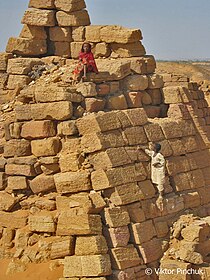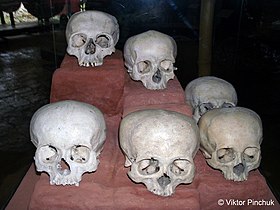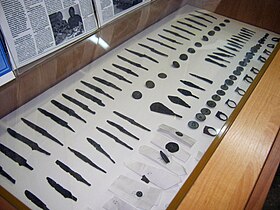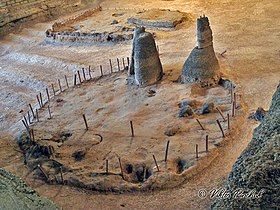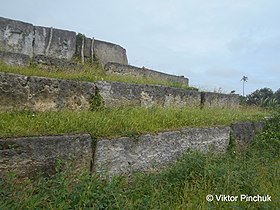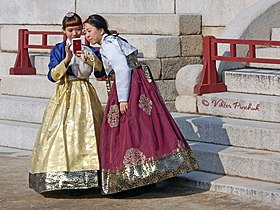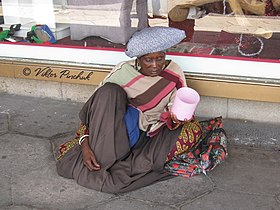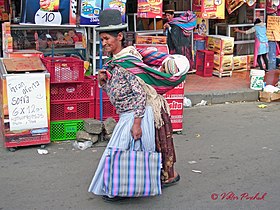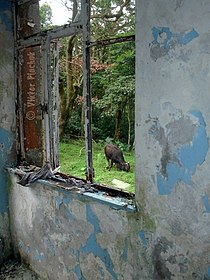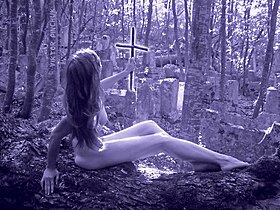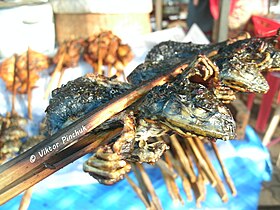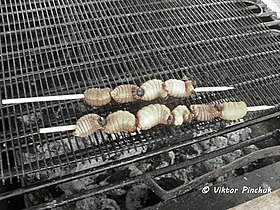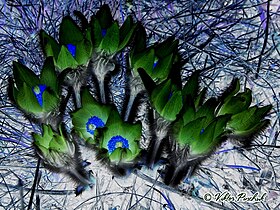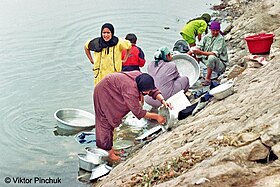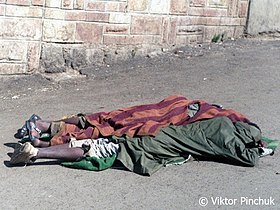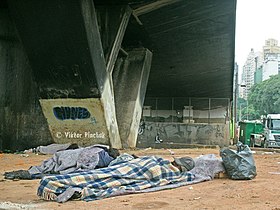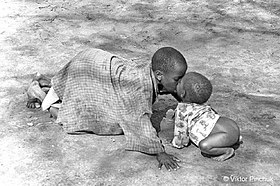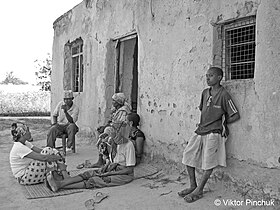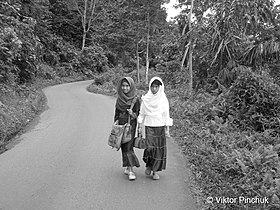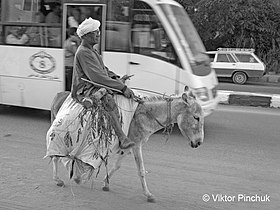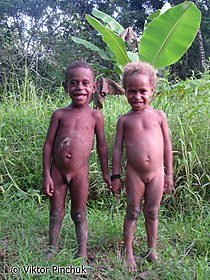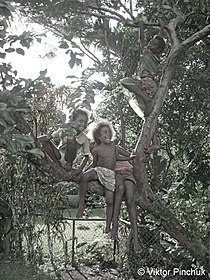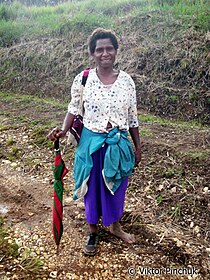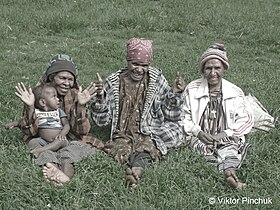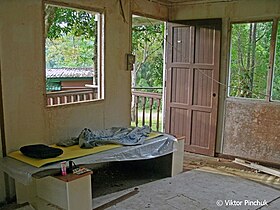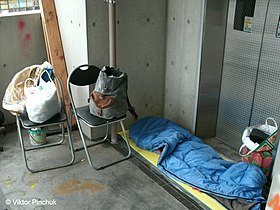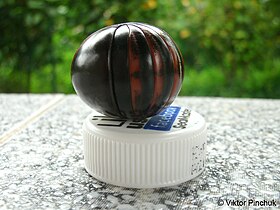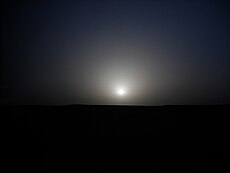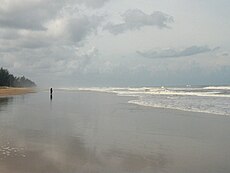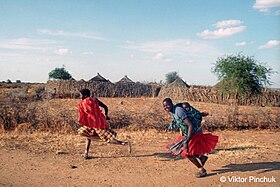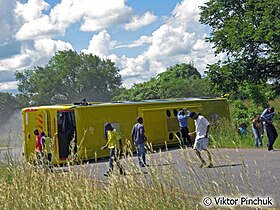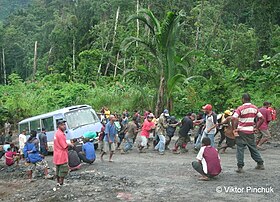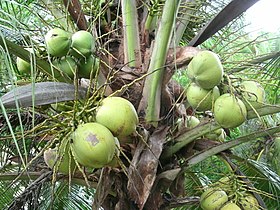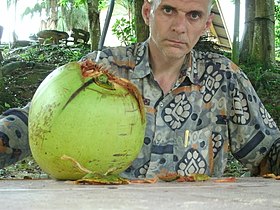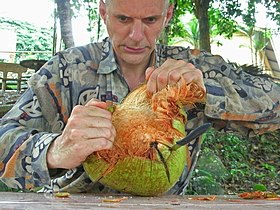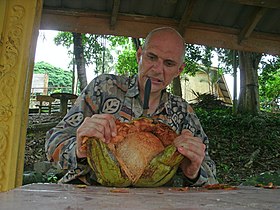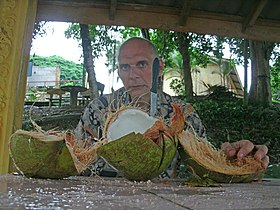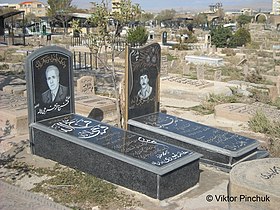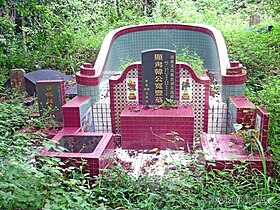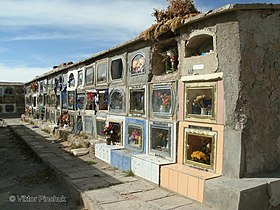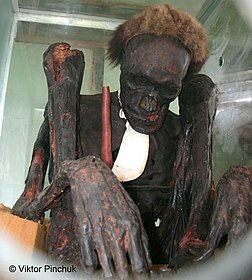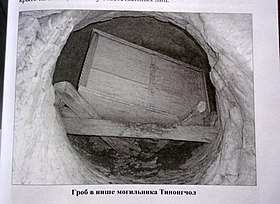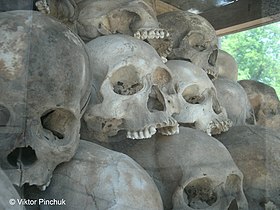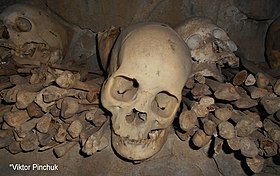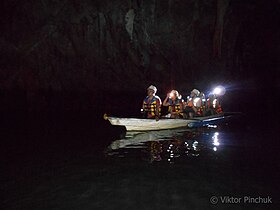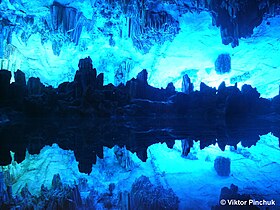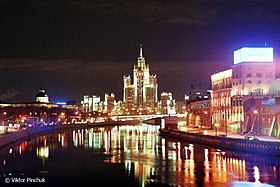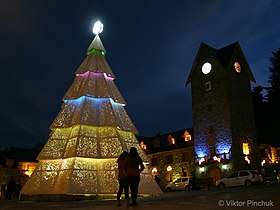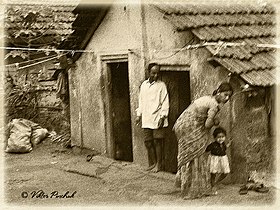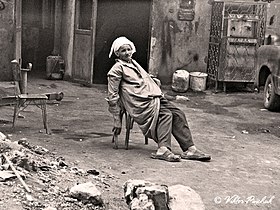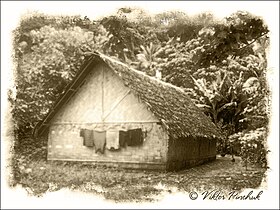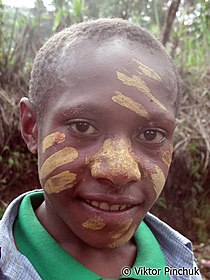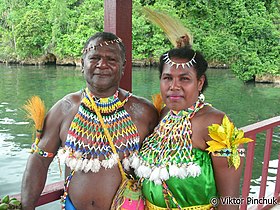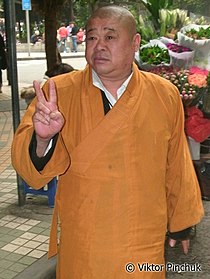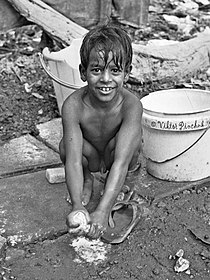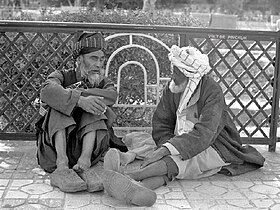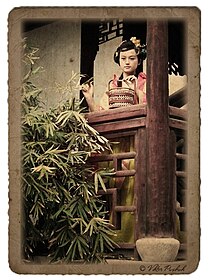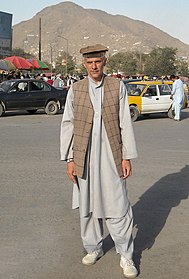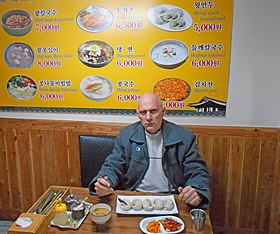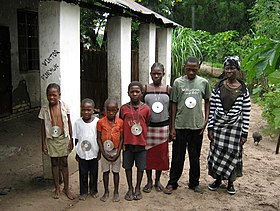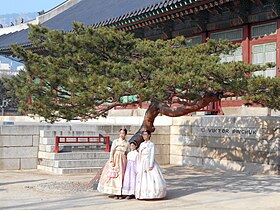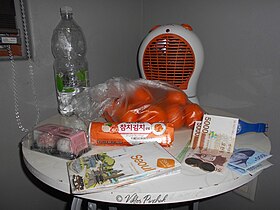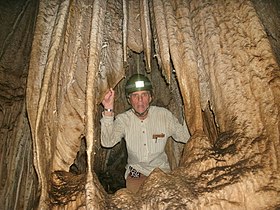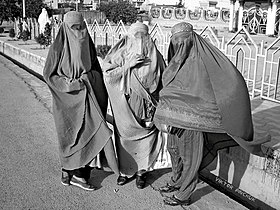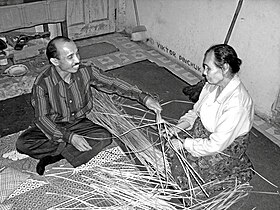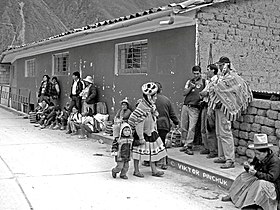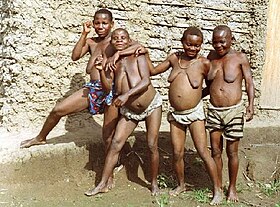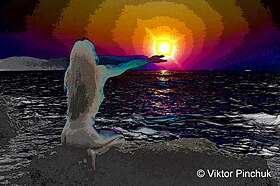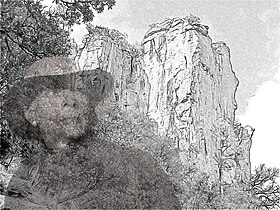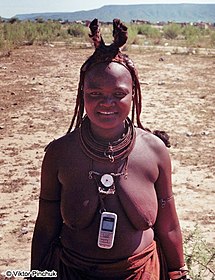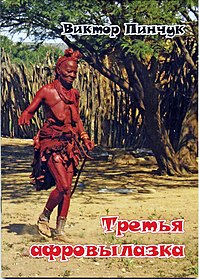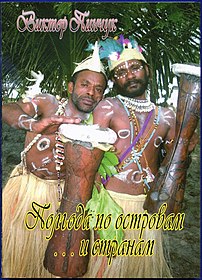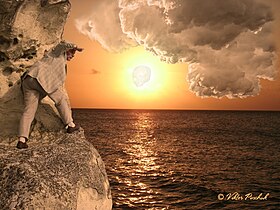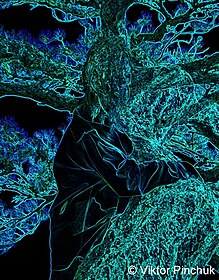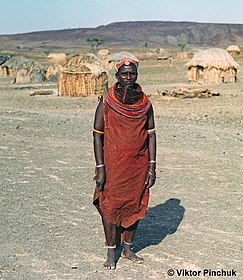Basics of fine-art photography/Printable version
| This is the print version of Basics of fine-art photography You won't see this message or any elements not part of the book's content when you print or preview this page. |
The current, editable version of this book is available in Wikibooks, the open-content textbooks collection, at
https://en.wikibooks.org/wiki/Basics_of_fine-art_photography
Creating works in abstract photography

Abstract photography is a genre that is the art of displaying a visual image that has no direct connection with objective world.
General information
[edit | edit source]Abstract photography, also known as non-objective photography, replaces the usual dogma of image recognizability by offering a kind of unreal image instead. A fragment of the natural scene is isolated in order to hide the original context from the viewer. Works in this genre are deliberately staged, demonstrating a seemingly fantastic combination of objects. The effect is achieved with the help of lighting solutions, shades, shadows, and textures; the goal pursued is to convey a feeling, sensation, or other impression.
This genre is based on the perception of form, color and lines (rather than the details and objects characteristic of a conventional image). Proponents of creative direction, abstracting from patterns and stereotypes, moving away from the standard representation, visually transfer the viewer to the world of strange, mysterious images.
Ways of implementation
[edit | edit source]You can create an abstract image using a standard set of photographic equipment — camera, darkroom, computer; or by direct manipulation of film, paper and other media, including digital ones.
The ability to think outside the box is important, combining an artist and a surrealist; to see a hidden mean in object that is featureless at first glance.
The photographs presented on this page were created by the author in 2022 (based on available material) specifically for Wikibooks and have not been previously published.
Gallery
[edit | edit source]-
Radio waves
-
Something
-
Winter
-
Horror
-
Scratching
-
Chaos
-
Good morning!
-
Stuff
-
Failure
-
Rampage
Creating works in archaeological photography

Archaeological photography is a genre of photographic art that specializes in displaying the material sources of the stages of human evolution.
General information
[edit | edit source]This genre has points of contact with scientific, reportage and travel photography. In the first case, shooting is carried out to fix the results of research; in the second — for illustrations of journalistic articles published in the media; in the third - in order to preserve the memories of the visited objects (archaeological areas, the ruins of disappeared civilizations, museum objects, etc.)
Ways of implementation
[edit | edit source]The presence of a press card, in particular, a document of freelance correspondent of a print edition (which is feasible in the absence of specialized education in this field), opens up the possibility of getting to archaeological sites, allowing you shoot artifacts extracted by specialists from the cultural layer, as well as the process itself. In other cases, you can visit places open to the public. Historical and archaeological objects, as a rule, are protected by the state on whose territory they are located, a fee may be charged for inspection.
Some examples from the textbook author's practice (in ru):
- The Great Wall of China, unrestored section (China)
- Uyu Uyu, ruins of an ancient city (Peru)
- Tia Seu Ancient Mound, the largest and most ancient structure in Oceania (Samoa).
Gallery
[edit | edit source]-
Artifact from the Pulemeley mound (Photo from book Two months of wandering and 14 days behind bars)
-
Mummy from Bangao cave (Philippines)
Photo taken on the Expedition to Oceania -
Pyramid of the ancient kingdom Meroe (Sudan).
Photo taken on the Third African trip -
Exhibits of the arch. complex Tonina (Mexico).
Photo taken on a Latin American expedition -
Reportage photo from an exhibition of artifacts from the textbook author's collection.
Joya de Cerén, archaeological site in El Salvador (Photos taken on a Latin American expedition)
-
Domestic complex
-
Kitchen
-
Mayan workshop
(Photo from book Two hundred days in Latin America) -
Place for important ceremonies
-
Temazcal (steam room)
Langi — terraced tombs on the island of Tongatapu, Tonga (Photos taken on the Expedition to Oceania)
-
Langi (1)
-
Langi (2)
-
Paepae o Tele'a
(Photo from book Two months of wandering and 14 days behind bars -
Langi (3)
-
Paepae o Tele'a (fragment)
Creating works in candid photography

Photo taken on an Afghan expedition
Candid photography is shooting style, where the spontaneity of the situation is taken as the basis.
General information
[edit | edit source]It is the exact opposite of staged photography; has some similarities with street photography, but the latter does not exclude that subject noticed the camera lens aimed at him (and managed to react emotionally), while an unbiased photograph implies the opposite. The decisive factor is the lack of posing.
Ways of implementation
[edit | edit source]You will need spontaneity, speed of reaction and a camera, that is always at hand; in addition — a certain talent for seeing the situation, and sometimes just luck — when the photographer is in a certain place just at the right time.
It is more convenient to use point-and-shoot, which are small in size, or use a camera built into a mobile phone.
If you are a supporter of "serious equipment", usually distinguished by its large size, you can use a model with an angle-change viewfinder, that changes the angle, which will allow you to take photos even while standing with your back to the intended object. But it is better, nevertheless, to dwell on the previous version.
Should know
[edit | edit source]In some African countries aborigines do not like to be photographed, in particular, unexpectedly, without warning. In the Comoros and Ethiopia, locals may react aggressively to a camera lens pointed in their direction. You can make sure of that with a concrete example. Never point the lens at an Ethiopian in uniform, be it a policeman or a military officer.
Those who speak Russian can read the article by the author of the textbook, which is published in Wikisource, by clicking on the link below.
Gallery
[edit | edit source]-
Serenity (Afghanistan, 2008)
Photo taken on an Afghan expedition -
Female Secrets (South Korea, 2018)
Photo taken on the Expedition to Oceania -
Little rider (Laos, 2013)
Photo taken on a Papuan expedition -
Sleep at work (Namibia, 2011)
Photo taken on a Third creative trip to Africa -
Four plus one (Kambodia, 2013)
Photo taken on a Papuan expedition
-
Weekend (Brunei, 2013)
Photo taken on a Papuan expedition -
On the market (Bolivia, 2015)
Photo taken on a Latin American expedition -
Street musician (Samoa, 2019)
Photo taken on the Expedition to Oceania -
Schoolgirls (Indonesia, 2013)
Photo taken on a Papuan expedition -
Gossips women (Panama, 2015)
Photo taken on a Latin American expedition
Wikisource
[edit | edit source]
Creating works in conceptual photography

Conceptual photography is a genre (type, style) of photographic art, where the author develops original (peculiar, unusual) ideas for subsequent implementation in his own works.
General information
[edit | edit source]The genre has points of contact with staged photography; conceptual works are distinguished by extravagance and unusuality; sometimes there are present elements of surrealism and minimalism.
At the origins of this genre lies conceptualism, a creative movement that emerged in the 1960s, whose proponents argued that an object becomes a work of art not because it has aesthetic values, but primarily due to the desire of the author (that is, at the artist, in a generalized sense of the word). Probably the first experimental works with a conceptual bent were made much earlier than the period mentioned above.
Conceptual photography is usually staged, but, theoretically, it can be random — when author, seeing a “scene” worth capturing, instantly directs the lens and presses the button.
Step-by-step instruction
[edit | edit source]- Mentally create a sketch.
- Prepare everything that is required to implement the idea: paraphernalia, decoration elements, participants (if any will be involved in the plot), not forgetting the correct location of the light source (s).
- Make sure that composition corresponds to the set theme and looks aesthetically pleasing.
- Need a previsualization of the scene, that is, a preview before shooting, rough animation sketches, allowing you to experiment with the arrangement of objects and participants, lighting, camera positioning — to be able to choose the best option.
- Post-processing also plays a role: elements of different images can be combined into one.
- The name of a photographic work (also like the title of a book or a movie) should smoothly “glide” along the plot, not revealing the meaning directly.
- It is important that your work makes the viewer think. The purpose of conceptual art is not to display an idea, but to encourage reflection through photography.
The photographs by the author of this textbook, presented in the gallery, will help you become visually familiar with the topic you are studying.
Gallery
[edit | edit source]-
The window of life (2013)
-
Eternal light (2009)
-
Repentance (2009)
-
Countdown (2010)
Creating works in a documentary photography

Photo from the book «Third African trip» p. 48
Documentary photography is a direction of photographic art based on the reproduction of real events.
General information
[edit | edit source]The genre includes the depiction of moments of everyday life, historical events, natural disasters, etc. It partly overlaps with reportage photography, but there are some differences, one of them — the more complex storyline. It also has some points of contact with ethnographic, street and genre photography; used in photojournalism, amateur and art photography.
Documentary photography is not limited to creating works with people in the frame, and may combine natural objects, fauna and inanimate objects, but in any case, the works of supporters of this branch of photographic art are emotional and related to human emotions.
Ways of implementation
[edit | edit source]It is impossible to give practical advice on how to achieve certain successes in documentary filming. In this case, the author's skill and practical skills do not take precedence over chance, and the time and place of events are sometimes difficult to predict. Always have a handy camera at hand, and luck will smile on you sooner or later. Better still, travel around the planet practicing hobo tourism, where adventures are always plentiful.
Photography of exotic (extraordinary) dishes

Photo taken on a Papuan expedition)

Photo taken on a Papuan expedition)
Photography exotic (extraordinary) food is a hybrid of two genres: food photography and travel photography.
Geberal information
[edit | edit source]Prerequisites of emergence
[edit | edit source]Food photography, in the classical sense, serves advertising purposes — a group of specialists, using studio effects (professional equipment, special lighting techniques, etc.), creates pictures of food for subsequent publication in magazines, posters, billboards, etc. In this case, the photographed objects are subjected to pre-processing, then exposure arrangement, which corresponds to the principles of staged photography.
Travel photography is a genre whose theme is the impressions of a traveler or tourist: the objects that he sees while moving along the chosen route, including dishes of traditional cuisine of overseas countries.
What this genre is?
[edit | edit source]Exotic food photography emerged by taking the theme of the first of the above genres and the methodology of the second.
On long intercontinental travels (however, as well as on standard tourist trips), there is no way to use a photo studio and carry with you bulky equipment. Work (shooting) in this subgenre involves the spontaneous action of a person who has arrived in a distant country, where many things differ from the usual realities, including dishes of Aboriginal, some of which at first can cause a slight shock.
Ways of implementation
[edit | edit source]Photo works are created in field conditions, spontaneously. Street sellers of exotic food do not always like the manifestation of attention to their product from a foreigner with a camera. For example, in Thailand, on Khaosan Road, where there are no less tourists than locals, vendors of fried scorpions put up a price tag, which indicates the cost of... providing the opportunity to photograph an unusual “product”. The reason is understandable: the number of those wishing to receive a memorable photo significantly outnumbers the number of gourmets.
Taking into account the above, we can conclude, that possibile two options:
- Act quickly and swiftly. When you spot an object of interest, point the lens, press the button on the move and continue on your way. Forget about manual settings: you will have to use the camera's auto mode. In this case, the result of your work may lag behind in quality, but will look more realistic, intersecting with a straight (pure) photography.
- Combining pleasant with the useful, buy a cockroach or a worm for tasting, which will allow you to capture the subject in the right perspective, by choosing the right lighting angle. In addition, in the eyes of the seller, you will acquire the status of a benefactor, increasing (with your symbolic "penny") his daily earnings. As a result, it is possible that he will allow you to take a picture of the cooking process without charging you extra for it. In this case, the photo will be classified as staged.
Carefully consider the photographs of the author of the textbook, in particular, the countries where they were taken.
Gallery
[edit | edit source]-
Fried guinea pig (Equador, 2015)
Photo taken on a Latin American expedition -
Newborn fried chicken (Philippines, 2019)
Photo taken on the Expedition to Oceania -
Frog skewers (Laos, 2013)
Photo taken on a Papuan expedition -
Larvae of the palm weevil (Equador, 2015)
Photo taken on a Latin American expedition
See also
[edit | edit source]Dishes of native cuisine in long intercontinental expeditions
Wikisource
[edit | edit source]Viktor Pinchuk "Very tasty... spider!"
Creating works in experimental photography

(work from album NUances of fantasy)
Experimental photography is a genre of photographic art based on an artistic representation of an object or action consciously modified through figurative thinking.
General information
[edit | edit source]Experimental photography is a subclass of conceptual photography, the subgenres of this direction are surrealism and subjective photography.
The goal is to explore the possibilities of photography through trial and error.
Viewers may ambiguously evaluate experimental works: many are accustomed to the classic, documentary reflection of reality, which will lead to a subconscious rejection of "incomprehensible", sometimes abstract topics.
Ways of implementation
[edit | edit source]In order to create a more or less interesting photo work related to the described genre, you need to be able to see world around us outside the box, sometimes with a certain degree of philosophical understanding.
Technically, you should use such techniques as pseudo-solarization, double (or multiple) exposure (see photo 2 in the gallery), photogram, blurry image effect. In addition, a wide range of digital post-processing software is at your disposal. In other words, you should experiment, as indicated by the root of the word displayed in the title of this chapter.
The reaction of an ordinary viewer can not always serve as an indicator. If your creation was not appreciated by a neighbor or a colleague, it does not mean that it is not aesthetic enough, but in the case of a negative assessment by a specialist, it is worth changing the direction of creativity.
It is difficult to imagine a ready-made recipe for creating images of this kind. Carefully look at the author's photographs as examples, try to come up with an original theme that is not like anything you have seen before.
If this genre does not appeal to you, close the page and choose another chapter of the textbook for yourself, for example, documentary photography.
Description of the image processing methods presented in this chapter of the textbook
[edit | edit source]- "Coming from the past" (in the upper right corner of the page); "Delusion" (photo No. 2 in the gallery) — double exposure on the same frame, plus post-processing with a graphic editor.
- "Lunar Landscape", "Path of the Dead", "Unearthly Flowers" (photos No. 1, 4, 5 in the gallery) — post-processing by graphic editors.
- "Happy NU year!" (photo No. 3 in the gallery) — long exposure (approx. 30-60 seconds), as a result of which employed sparklers (3 pcs.) visually merged into one.
Gallery
[edit | edit source]-
Lunar Landscape (2010)
-
Delusion (2005)
-
Happy NU year! (2005)
-
Path of the Dead (2010)
-
Unearthly flowers (2010)
Creating works in a genre photography

Photo from the exhibition "Egypt and Egyptians III"
Genre photography is the skill of depicting seemingly simple everyday scenes from an artistic perspective.
General information
[edit | edit source]Genre photography and street photography can be considered related concepts, but the former came into being a little earlier. While there are many similarities between these genres, there are also differences: the former focuses on the subject and the latter — on the visual side of the photograph.
Tips
[edit | edit source]In choosing this genre, you should be mobile, agile, observant and has compositional vision.
Each of your works should encourage the viewer to reflect on what came after, and perhaps before, what he see in the photo. If there is no storyline, the photo belongs to a different genre.
More information
[edit | edit source]Ihere are also some similarities between genre photography and reportage photography, with the former necessarily being artistic while the latter may not be so: to illustrate newspaper articles, for example, the images may have minor flaws. This should be borne in mind when you choosing genre.
Gallery
[edit | edit source]-
The look (Afghanistan)
Photo taken on an Afghan expedition -
An exasperated woman (Ethiopia)
Photo taken on first African trip -
Dishwasher (Egypt)
Photo taken on first African trip -
Stopover (Uganda)
Photo taken on the second African trip -
Who settled in the pyramid? (Sudan)
Photo taken on the third African trip
Creating works in a high key

Photo from the book «Six months by islands... and countries», p. 147
High Key is a method of lighting used in photography to create a special artistic effect, characterized by minimal contrast and the absence of dark tones.
General information
[edit | edit source]To create photographs in a high key, very bright lighting should be used, affecting the shadows present to such an extent that they will almost not be noticeable. In the strictly classical sense of the method, the result should not contain dark grey and black details, but a modern interpretation suggests minor inclusions, such as black eyebrows in a portrait.
Useful advice
[edit | edit source]If you are planning to shoot outdoors, it is advisable to do so on a clear day with side lighting and, of course, a light (or white) background.
If practising indoors, you will need to do some preparatory work.
Ways of implementation
[edit | edit source]To create a perfect photograph in a high key will require a considerable investment of money to purchase the appropriate equipment and accessories. However, possibile get your first skills with an ordinary room. You can start by taking portraits. Use a perfectly white material as a background: a wide roll of paper or at least a piece of white cloth without any patterns, texture or small spots. You'll need four light sources, two of which — the main (brighter) and the fill light (extra) should be directed at the person being photographed, placing them on the left and on the right; the rest (less powerful) should be used to light the background. The result will be a life-affirming image with a positive tone.
Possible mistakes
[edit | edit source]The photo may turn out to be contrasting.
See also
[edit | edit source]
Taking pictures of homeless people

Photographing homeless peopleis a sub-genre of portrait photography, where the author depicts people who dont have permanent housing, in their own particular environment.
General information
[edit | edit source]Officially, such a style, direction, subgenre does not exist - there is no mention of it in photography textbooks and encyclopedic articles, but since there are works related to this topic (see examples below, in the gallery), it can be considered as subgenre of photography, belonging to the "Portrait".
In addition to homeless people, the shoot may include the depiction of down-and-out people who have housing (in ru: бич), as there is often no visual distinction between the former and the latter. In addition to images of homeless people, the shoot may include the depiction of down-and-out people who have housing (in ru: бич), as there is often no visual distinction between the former and the latter.
A photographer who specializes in this sub-genre may be shooting homeless people in the area of his residence (city, region, country), or around the world (like the author of this textbook, combining photography and non-standard travel).
Photography of the homeless is in close contact with straight photography, intersects with street, genre and documentary photography; is often an candid photography.
Ways of implementation
[edit | edit source]To create a realistic photograph of homeless person, you must use the shooting techniques described in the "Realism" chapter of this textbook.
Combining work in this creative direction with traveling around the planet — in addition to all the genres and styles listed above, you will learn the intricacies of travel photography, and if objects (i.e. homeless people) are captured in situations that suggest reflection, then you will master one more genre — narrative photography.
It's interesting that...
[edit | edit source]- In Cuba, India, Bolivia and some other developing countries, it is sometimes difficult to distinguish between person who has a dwelling and a homeless.
- The author of this textbook, wandering around the globe, himself often looked like a homeless (image). You can get acquainted with the adventures of a hobo tourist in Wikisource by clicking on the link below.
Gallery
[edit | edit source]-
Addis Ababa, Ethiopia (2006)
Photo taken on first African trip -
Tokyo, Japan (2012)
Photo from a bum tour of winter Japan -
Manila, Philippines (2019)
Photo taken on the Expedition to Oceania -
São Paulo, Brazil (2015)
Photo taken on a Latin American expedition -
Taipei, Taiwan (2018)
Photo taken on the Expedition to Oceania
Wikisource
[edit | edit source]- Viktor Pinchuk "Notes of an international tramp"
See also
[edit | edit source]
Creating works in humanistic photography

Photo taken on a Papuan expedition
Humanistic photography is a genre that focuses on depicting everyday life of ordinary people, where the author's work directly or indirectly contains optimism, sometimes shades of romance.
General information
[edit | edit source]The origins of the creative direction is usually associated with France of the 30-ies of the XX century; the peak of popularity, during which the genre spread in Europe and beyond — with the postwar period (1945 - 60s).
Intersects with street, genre and, in part, reportage photography (difference: the latter is aimed at depicting specific events, while humanistic photography is not tied to events and dates). Preference is given to black and white tones. Supporters of this genre can be called "poets of the lens".
Ways of implementation
[edit | edit source]How to create works in this genre? There is nothing easier! Take a small backpack with essentials, purchase a ticket to any overseas country (preferably from among the poor), which will be the starting point of your route. Attach an inexpensive compact camera to your belt with a spare set of batteries…
The plots are already waiting for you, just need to be in one or another point of the globe in time, deftly get the camera out of the case, point the lens and press the shutter release button. After return a few months later, go through the footage. In the meantime, carefully review works of textbook author, made in different parts of the world.
Gallery
[edit | edit source]-
Romantic couple (Delhi, India, 2006)
Photo taken in creative trip to India -
Kiss (Bundibugyo, Uganda, 2007)
Photo taken on a Second creative trip to Africa -
Rider (Mazar-i-Sharif, Afghanistan, 2008)
Photo taken on an Afghan expedition -
Hot afternoon (Kwamtoro, Tanzania, 2010)
Photo taken on a Third creative trip to Africa -
Girlfriends (Samosir Island, Indonesia, 2013)
Photo taken on a Papuan expedition
-
Who quickly? (Aswan, Egypt, 2010)
Photo taken on a Third creative trip to Africa -
Weekend (Tutong, Brunei, 2013)
Photo taken on a Papuan expedition -
Goat riding (Bayamo, Cuba, 2015)
Photo taken on a Latin American expedition -
When work is joy (Savaii Island, Samoa)
Photo taken on the Expedition to Oceania
The photos were taken in Papua New Guinea, during another solitary expedition of the author (2013)
-
Knowledge is Power!
-
The perfect couple
-
Carefree
-
A woman in one shoe
-
Leisure
Interior photography in hobo tours

Interior photography in hobo tours is an informal genre that combines elements of interior photography and ruins photography.
General information
[edit | edit source]This is a direction of photographic art known to only a few: those who are involved in photography and bum tourism at the same time.
A characteristic feature is the shocking for viewer, unusual, destroying stereotypes about staying on foreign trips, the display of accommodation facilities. The presence in the frame of the "bed" of an international tramp is an additional detail, without which a photograph of this type would look less documentary.
Ways of implementation
[edit | edit source]The space where you are going to take your pictures is not always sufficiently lit by natural light, so you'll need a flash. You should preferably use a wide-angle lens (which always important for interior photography) in order to capture as much space as possible, but if you don't have one, you can applied a normal lens.
In any case, the compositional solution is of paramount importance, the correctness of which, combined with the storyline, will be decide by the viewer's imagination, turning your photo work into a separate story.
Gallery
[edit | edit source]-
Tramp apartments, Sabah (Malaysia)
Photo taken on the Papuan expedition -
Overnight near the lift at student residence in Kyoto
Photo from a bum tour of winter Japan -
Abandoned house, Kuala Lumpur (Malaysia)
Photo taken on the Papuan expedition -
A hotel room in Cairo (Egypt)
Photo taken on the Third trip to Africa -
Overnight stay in ruins, Port Vila (Vanuatu)
Photo taken on the Expedition to Oceania
Creating works in macro photography

"Two months of wandering and 14 days behind bars", p. 77
Macro photography is the creation of optical images, where, according to the Great Russian Encyclopedia, the scale is from 1:5 to 10:1 or higher.
General information
[edit | edit source]The method is used to display small objects in full size or with magnification; (the smallest objects are displayed using photomicrograph).
For professional purposes, special accessories are used: supplementary lenses, extension rings, short-throw lens, etc.
Ways of implementation
[edit | edit source]With the simplest digital camera, you can get a decent result. Many "point-and-shoot" models have a “macro” mode, using which, you should bring the camera closer to the object being shot, while not forgetting to increase the shutter speed, because the image illumination decreases as the distance decreases. If your model has a depth-of-field option, use the maximum setting to ensure that the finest details are captured.
In any case, in the era of digital technology, trial and error will help.
The use of bulky detachable lenses and tripods, contradicts the principles of the author, who is a supporter of hobo tourism, so if you are interested in an in-depth understanding of macro photography theory, look at the works of creator this article, which were made with a primitive camera and... try to find another textbook — more thorough and detailed one.
Gallery
[edit | edit source]-
Woodlouse (Malaysia)
Photo taken on a Papuan expedition -
Onymacris unguicularis (Sudan)
Photo taken on a Third creative trip to Africa -
Dactylotum bicolor (Namibia)
Photo taken on a Third creative trip to Africa -
Scolopendra cingulata(Thailand)
Photo taken on a Papuan expedition -
Caterpillar (Russia)
Photo taken in Crimea
Creating works in a minimalist photography

Minimalism is a style of photographic art, where the author's work is distinguished by the utmost simplicity of execution.
About style and implementation methods
[edit | edit source]Minimalism emerged as an artistic trend in the 60s of the last century, later, in addition to painting, it began to be used in photography. The style involves a minimum of depicted objects, shades, shapes and textures, as a result of which the viewer's attention is concentrated on the central object, without being distracted by details.
To create a minimalist photo work, you should choose a time of day or a season when there will be as few people around as possible and objects that fall into the frame. For example, at the early morning in the city, or in the snowy winter at forest. In any case, you will need imagination and the ability to improvise. In addition, you should pay attention to the artistry and content of photography. You can photograph a small fly on a large plain wall, or an apple on the pavement - this will also be minimalism, but ... a photographic work should carry in itself something special, arouse the viewer's desire looking at it for a long time, thoughtfully. Will someone should want look at the fly?
Important to know
[edit | edit source]Use the rule of thirds when choosing a compositional solution.
More
[edit | edit source]A picture is worth a thousand words. Take a look at the photographs of the author of this article as an example, they will silently tell you more about minimalism than long educational texts.
Gallery
[edit | edit source]-
Sunset (Afghanistan)
Photo taken on an Afghan expedition -
Splash (Samoa)
Photo taken on the Expedition to Oceania -
The waterfront in Alexandria (Egypt)
Photo taken on a Third creative trip to Africa -
Salar de Uyuni (Bolivia)
Photo taken on a Latin American expedition -
Deserted beach (Brunei)
Photo taken on a Papuan expedition
Creating works in narrative photography
Narrative photography is a genre which allows a photographer to test himself in the role of a "writer", creating works that silently tell to viewer the stories of depicted objects.
General information
[edit | edit source]Narrative photography may consist of several parts, where each subsequent image continues the previous one, but the classic version — when author's single work can tell a story that a person who has imagination will comprehend.
Ways of implementation
[edit | edit source]The genre overlaps with street, genre, documentary, and reportage photography described in the textbook. For creating an original works you need to be in a state of motion, moving between cities, countries, continents; always have a camera at the ready, because an interesting scene can appear to you unexpectedly. It is not difficult to guess that travelers, in particular supporters of hobo tourism, overcoming multi-kilometer routes of long intercontinental wanderings, involving many meetings with people of different views, religions and ethnic traditions, have more chances.
Consider the examples below.
- Anger. The reaction of an Ethiopian woman to the mzungu camera lens: Ethiopians don't like to be photographed, like the inhabitants of some other African countries.
- Escape. A similar case. The reaction of girls from the Ugandan hinterland to the camera in the hands of a white foreigner.
- Who settled in the pyramid? Local children look into pyramid of the ancient kingdom of Meroë, where a weird stranger lay down to rest.
- Branding. In the wilds of Tanzania, the Barabaig people brand a pet, not to show it to the traveler, but because it is necessary.
- Car accident. Two passenger buses were moving along the highway from Windhoek to Lusaka, the second one tried to overtake. The author of the photo was in the first, surviving vehicle.
- Queue. A crowd of people who want to go down from the Huangshan mountain range with the help of a cable car.
- Staring into the abyss. Five Laotian monks carefully and thoughtfully peer into the abyss of falling water. What are they thinking?
- Breakage on the way. Intercity bus stuck in the middle of the Papuan jungle. The author of photo was present as a passenger.
- Decay. The photo was taken in a suburban wasteland, wich turned into a spontaneous dump by locals. Disposes to philosophical reflections on the frailty of being.
- By surprise. (or Uninvited guest). A tiny village in the deep jungle of Pentecost Island. A sudden press of the camera shutter button. Didn't anticipate?
- 12. 13. 14. 15. Coconut fight. True photo story of how the author, with difficulty knocked down a coconut, and tried to open it with improvised means. Was published in the newspaper "Republic of Crimea" dated 13. 12. 2013. — No. 28 (1000).
From the description, we can make a logical conclusion that the creation of photographs in this genre requires time, effort and (preferably) moving around the planet.
Gallery
[edit | edit source]-
Anger (Addis Ababa, Ethiopia, 2006)
Photo taken on a First creative trip to Africa -
Car accident (Namibia, 2011)
Photo taken on a Third creative trip to Africa
-
Queue (Huangshan, China, 2013)
Photo taken on a Papuan expedition -
Breakage on the way (Papua New Guinea, 2013)
Photo taken on a Papuan expedition
Photos taken in Malaysia, during the author's expedition to Papua New Guinea (2013)
-
Prologue
-
Coconut fight (1)
-
Coconut fight (2)
-
Coconut fight (3)
-
Epilogue
Creating works in necrophoto

Photo from book "Two months of wandering and 14 days behind bars"
Necrophoto (photography related to death) is a neologism used by the author of textbook to designate a genre where the objects of photography are burial places, ritual (funeral) paraphernalia, remains of people, mummies, relics, and everything that is related to death and subsequent events/processes.
If the age of the subject is several hundred years old, photographic works can be attributed to the intersection of two genres: the one described in this article and "archaeological photography".
General information
[edit | edit source]This theme has been used in the history of photographic art since the invention of the camera. However, to this day, “photography associated with death” does not have a stable classification, and has not taken one of the places in the hierarchy of genres. The encyclopedia reports only about "Post-mortem photography", where the subject of the shooting are deceased people, which "posing", like the living; however, topic is limited to the indicated scope and does not include what is listed in the preamble of this article.
Ways of implementation
[edit | edit source]The genre of "necrophoto" can serve both documentary and artistic purposes, depending on the choice of the author. Since this textbook is directly related to art, the emphasis will be on the artistic side of the issue.
In my opinion, the combination of necrophoto and travel photography is the most interesting.
The traditions of the world associated with the funeral ritual and other actions accompanying the death of fellow tribesmen (such as mummification, etc.) are worthy of being captured. For example, the Ma'nene Festival in Indonesia, during which aborigines temporarily remove the bodies of long-dead relatives from the ground in order to return them to their graves after a short “communication”; or Merry Cemetery in Romania, there are many examples. The attitude towards death among the natives, the so-called exotic countries, is fundamentally different from the perception of this fatality by Europeans, therefore, the photographs taken by you will arouse interest among compatriots upon your return.
As for the choice of space for actions, transport and ways of moving, the Internet and your own imagination will help you, and 15 examples from the practice of the author of this article can be seen in the gallery below.
Gallery
[edit | edit source]-
Tabriz (Iran)
Photo taken on an Afghan expedition -
Bandar Seri Begawan (Brunei)
Photo taken on a Papuan expedition -
Cachi (Argentina)
Photo taken on a Latin American expedition -
Uyuni (Bolivia)
Photo taken on a Latin American expedition -
Chichicastenango (Guatemala)
Photo taken on a Latin American expedition
Photos from books "Two months of wandering and 14 days behind bars"; "Six months by islands... and countries"
-
Coffins from Bangao Mummy Cave
(Kabayan, Luzon Island, Philippines) -
Mummy from Bangao Cave
(Kabayan, Luzon Island, Philippines) -
Mummy in Pasir Putih
(West Irian, Indinesia) -
Mummy II from Bangao Cave
(Kabayan, Luzon Island, Philippines) -
Tinongchol Burial Rock
(Kabayan, Luzon Island, Philippines)
-
Killing Fields (Phnom Penh, Cambodia)
Photo taken on a Papuan expedition -
Scull from Tiwanaku (Bolivia)
Photo taken on a Latin American expedition -
Opdas Cave (Kabayan, Luzon Island, Philippines)
Photo taken on the Expedition to Oceania -
Skeletons from Teotihuacan (Mexico)
Photo taken on a Latin American expedition -
Sculls from Toniná (Ocosingo, Mexico)
Photo taken on a Latin American expedition
External links
[edit | edit source]- "You look like death warmed up! Indonesian villagers dig up their ancestors every three years and dress them in new clothes in ancient ritual to show 'love and respect'". dailymail.co.uk. Retrieved April 23, 2023.
- "NECRO — dictionary meaning of the prefix". crossword-opener-en.slovaronline. Retrieved April 23, 2023.
Creating works in neosurrealism photography

Neosurrealism is a genre in the visual arts that differs from its predecessor in the absence (obligatory for Surrealism) of the main idea — automatism.
About genre and ways of implementation
[edit | edit source]To create works in this genre, it is not necessary fall into a trance, communicate with the spirits of the dead, aliens from another worlds, or use drugs. It is enough to have imagination and a computer with a minimum set of graphic editors; like Photoshop or Sketch.
You won’t even need to take special neo-surrealism training courses (there are none, besides, in the absence of innate imagination, they are unlikely to help); more effective — will to experiment with original photographs and a margin of time.
Creating works in a low-key

Photo taken on a Latin American expedition
Low-key is a method of lighting used in photography to create a special artistic effect.
General information
[edit | edit source]The meaning of the method is to highlight certain parts of the photographed object, while the rest remain dark, which is how the originality of the result is achieved.
When shooting outdoors, you can find a ready-made scene, all that remains is to correctly display it using a tripod or improvised means.
For studio photography, you have to create the conditions yourself.
Ways of implementation
[edit | edit source]It is not necessary to use a special equipped studio — a darkened room is enough to start. If you want to create a portrait, cover the wall plane to be used as a background with any dark (preferably black) material. The discreet lighting technique suggests uses a single key light source, which can optionally be controlled by a reflector to create a fill light. As a result, a kind of gloomy, dramatic effect is achieved.
When manipulating the source of light, try to choose an angle for the poser so that the hard shadows fall on certain parts of the face. Avoid direct light hitting the background so that the photograph does not show its texture, but only a solid, evenly distributed black colour. The light fixture (or flash) used should not be too powerful, and if there are no others, you should cover the plane of the outgoing rays with a white or light cloth.
Possible mistakes
[edit | edit source]The result of too little exposure will be an image with missing details in dark areas, or total blackout ; too much exposure will result in an image with missing detail in light areas, or even no image at all. Be prepared for the fact that the first result may disappoint you: experience does not come immediately.
Gallery
[edit | edit source]-
Evening street (Malaysia)
Photo taken on a Papuan expedition -
Sunset (Afghanistan)
Photo taken on an Afghan expedition -
Puerto Princesa, underground river (Philippines)
Photo taken on the Expedition to Oceania -
Full moon on Labuan Island (Malaysia)
Photo taken on a Papuan expedition -
The waterfront in Alexandria (Egypt)
Photo taken on a Third creative trip to Africa
See also
[edit | edit source]
Creating works in night photography

Night photography — creating photographs outdoors at night, as well as as well as indoors without the penetration of light from outside.
About the genre and the ways of realization
[edit | edit source]Photography in this genre is traditionally carried out with a tripod, or clamp — if you use a small-format camera, as well as other devices that replace them. However you can do without accessories: the author of this text, who traveled through dozens of countries of the world by hobo touring, is an example of that.
It is enough to choose a flat support for your camera (for example, a curb, parapet, etc.) and, holding it firmly with both hands, press the shutter release button. If you don't hold the camera firmly enough during the exposure time, to get a blurry image. On the contrary, if you want to capture the "arrival of aliens" and abstract scenes, you should set a slow shutter speed and move the camera smoothly for several seconds. But that is another topic.
Usually a thirty-second exposure is enough to capture the lights of the night city from the observation deck; if it is a night street of a metropolis, — you'll need half that amount of time. In any case, you can experiment with shutter speeds by removing bad frames.
The only case when method "without a tripod" is more difficult to use - in a large area without elevations, boulders and benches, such, as Red Square in Moscow. You could try taking pictures from the floor (sidewalk, ground) placing an improvised small item under the front part of the camera's lower plane to give it a certain angle. The result will be worse than with rigidly fixed elevation, but better than with handheld photography (where the maximum possible exposure is 1/30 second, which of course is not enough). When shooting the view from the bridge, you can use the railing. In general, ultralight backpacking, you will have to sacrifice some views of the night cities of the globe. In some cases, as an option, you can ask someone for a stool, — a method were used by the author when photographing the night trade in Khan el-Khalili market in Cairo.
This should be known
[edit | edit source]Using this method, you can do without a flash when shooting a night city or a cave equipped with illumination. Moreover, the author experimented by photographing people against the background of night lights (for example, on the bridge, behind which there is the Moskva River glowing with lights), making a photos with and without flash, but in both cases using slow shutter speeds (long exposures). The result was the same. The main condition is that the person posing must not move during the exposure.
Gallery
[edit | edit source]-
Tokyo Tower (Japan)
Photo from a bum tour of winter Japan -
Reed Flute Cave (China)
Photo taken on a Papuan expedition -
Copacobana, Lake Titicaca (Bolivia)
Photo taken on a Latin American expedition -
San Carlos de Bariloche (Argentina)
Photo taken on a Latin American expedition
Creating works in nude photography (art)

Nude photography — a genre of photographic art whose subject matter is the artistic representation of a partially or completely nude human body.
In Russian, the word "ню" (nu) used for this genre, probably borrowed from Latin or French.
Where to start?
[edit | edit source]Realization of ideas is possible both in the studio and in nature. As the studio shooting requires special skills in the arrangement of light sources, beginners are recommended to make their first steps in this genre using natural light — sunlight or moonlight (about the latter — a separate article).
Selecting a background and subject
[edit | edit source]As a background, you can use any natural landscape - coastal cliffs, grove, sandy beach, rye field, sunflowers, or vice versa — the ruins of an abandoned building (nude photography against the scratched walls of the abandoned building, seemingly contrary to common sense and logic, may look picturesquely).
It is desirable to choose female persons who have reached the age of majority as an object for photography in the nude genre. Photographs of nude male representatives can be ambiguously perceived by society, so it is better to leave experiments with extravagance for the future, when your debut works will be appreciated. The use of persons of both sexes who have not reached the age of majority for shooting in the nude genre can lead to unpredictable consequences; in particular, someone may find it a illegal actions. Therefore if you really need something original, it is better to negotiate with elderly people. However, the result will not be perceived by society as artistically as similar works of painters due to the inherent realism of photography.
Timing
[edit | edit source]It is desirable to allocate a separate day for the photo session. If you don't live in the wilderness, you will have to go to the suburbs. Some time will be needed to adapt the person (model) to the upcoming process. There is no need to rush, this can have a negative effect on the result. Don't forget that the genre of nude — is not only the nudity of the body, but facial expression, — result should not be like a image convict before the execution. Also you should not prolong the process: more than three-four hours of continuous work will reduce your and the model's capacity for work, the first signs of fatigue will appear, and they will be noticeable in the pictures.
Choosing the angle, lighting and location of the person being photographed
[edit | edit source]One of the rules for photographers in the analog era was: "Minimum of takes!" It's understandable: the large-format film used by professionals was cost some money, and regular 35mm film was not free either. Modern digital technology does not limit the number of takes, which allows you to make a selection by reviewing the footage on the computer and, eventually, learn something in practice.
Advice
[edit | edit source]Sometimes it happens that with a well-lit background, the foreground (model) is in counter-lighting (the sun is behind). In such cases, the inclusion of a forced flash will give a good effect. By the way, there is a separate direction in photography, which can be considered a subgenre: Nude Silhouette Art. This type of shooting implies a wide range of the author's imagination and promises interesting results. One of the advantages: can't see the facial expressions of the people, which can bear the imprint of hard everyday life. Because you are not yet so eminent author to hire a fashion model of ideal shapes and proportions, isn't it?
Gallery
[edit | edit source]-
Silver streams, 2011
(Pictorialism) -
Repentance, 2009
(Conceptual photography) -
Girl by the stream, 2007
(Pictorialism) -
In the moon web, 2011
(Experimental photography)
See also
[edit | edit source]- NUances of fantasy — art album including 100 works and a text introduction.
Creating landscape photographs

Landscape is a genre of photography, where the main subject is virgin nature, — usually water bodies or earth surface.
A little bit of theory
[edit | edit source]Sometimes details not related (or indirectly related) to nature may be present in the frame, supplementing the content. For example: an African hut against a savannah background; a boat (floating on an Asian river) with a fisherman in asian conical hat; a wild animal against a jungle background, etc. But, in any case, these elements should not overlap a significant part of the backdrop.
Where to begin?
[edit | edit source]Creating works in this genre of photography is the easiest and most accessible way to gain first experience for beginners, as it does not require special skills required for studio shooting; another advantage is that no special accessories and additional equipment are required: tripod, flash, etc. Moreover, in our time of digital technology, a beginner will not face such difficulty as setting the exact shutter speed and aperture in difficult weather conditions, for example: snow-covered space combined with an overcast sky. In the recent past, when there was no alternative to analog photography, an inexperienced practitioner could ruin film in one session.
About lighting
[edit | edit source]Front and side sunlight should be used. Don't take pictures in the midday light. Perhaps with the advent of experience you will learn to get around this problem, or even adapt it to your goals, but this will be later.
Personally, I like time before sunset , when the sun's rays seem to glide along the surface of the ground. But with such a shooting, the photo turns out to be yellowish, which not everyone appreciates positively.
To prevent side light from entering the lens (resulting in glare in the image), you need to use a lens hood.
Small errors can be corrected later with the help of graphic editors on a computer; big mistakes are uncorrectable.
Gallery
[edit | edit source]-
Lake Khövsgöl (Mongolia)
Photo taken in Creative trip to Mongolia -
El Sillar (Bolivia)
Photo taken on a Latin American expedition -
Cunene River (Namibia)
Photo taken on a Third creative trip to Africa -
Bamyan (Afghanistan)
Photo taken on an Afghan expedition -
Tufuvai Beach ('Eua, Tonga)
Photo taken on the Expedition to Oceania
Creating works in panoramic photography

Photo from book
Panoramic photography is a catch-all term that characterizes a set of methods that make it possible to obtain images with a viewing angle of up to 360º.
General information
[edit | edit source]Panoramic (or wide-format) photography contributes to the display of objects that cannot be captured in the frame using regular and wide-angle lenses.
It can be horizontal (more often), or vertical; used for shooting natural and urban landscapes, interiors of buildings.
The advantage over a photograph taken with a wide-angle lens is the absence of distortion: if in landscape photography they are almost invisible, then in interior photography, alas.
Ways of implementation
[edit | edit source]Many modern cameras (including the simplest) have a panorama photo function, the algorithm of which differs depending on the model used.
- By instantaneous automatic docking of several sequentially made frames, where an auxiliary horizontal line and a small fragment of the previous frame allows you to minimize errors. The variant, where docking is noticeable (in this case, three frames) can be seen here: example.
- Some models offer to move the lens smoothly (as when shooting a video), resulting in a panoramic photo.
- There is such a variation: when the “panorama” mode is set, the camera captures standard frames that should be joined on the computer. The disadvantage of this method is that if the number of frames on the flash drive is in the hundreds or even thousands (as happens with the author of this textbook in long expeditions involving visits to ten or more countries), it is easy to confuse the frames intended to be combined with the rest, and delete part of them by mistake.
In addition to the above methods, you can create a horizontal panoramic image using a camera that doesn't have such a function: will need a tripod with a rotating head.
For an in-depth study of the topic, see the "Panoramic cameras and methods section" of the Wikipedia article.
Gallery
[edit | edit source]The photos were taken during the author's 200-day solo expedition (2014 - 2015).
-
Ciudad del Encanto, Bolivia (photo from book "Two hundred days in Latin America")
-
Laguna Colorada, Bolivia
-
Cusco (view from Sacsayhuamán), Peru
-
Iguazu Falls (Foz do Iguaçu), Brazil
-
Perito Moreno Glacier, Argentina (photo from book "Two hundred days in Latin America")
-
Guatemala City
Creating works in style of pictorialism

Pictorialism is a movement in photographic art, whose proponents, by manipulating the original image, give it additional features of artistry, as a result of which the photograph becomes similar to painting.
General information
[edit | edit source]The style of photographic art,, whose name comes from the word "pictorial", arose in the West at the end of the 19th century; it was a reaction to the recognition of photography as a static display of reality that had nothing to do with art. Probably, in those years, the concept “photo artist” (that is, a master of artistic photography) was born.
As a rule, in photographs belonging to this style, the image is blurred to one degree or another, which contrasts them with straight photography; and the shades are monochromatic, ranging from browns to pale blues.
Ways of implementation
[edit | edit source]The 21st century, in contrast to the period when the style was born, offers the author a wide range of opportunities for photo processing: first of all — a variety of graphic editors, however, “grandfather methods” can also be used if desired. At the same time, you need to remember that the original photo work must contain elements of artistry, otherwise post-processing will be powerless.
Blurry contours, ambient lighting, smooth transitions, preference for night and foggy scenes - these factors will help you in your work. For shooting, you should choose landscapes, portraits, nudes — these are the themes that prevailed in the works of the founders of the style.
I would like to remind you that this manual is intended to familiarize you with the basics of photographic art. Those who wish to study the subject in depth, including the historical premices to the emergence of the style, may refer to the encyclopedic article.
Gallery
[edit | edit source]-
Indian family (2008)
-
Hopelessness (2006)
-
Silver streams (2011)
-
Girl by the stream (2007)
-
Hut in the jungle (2019)
See also
[edit | edit source]Creating stylized retro photo works — educational article about the genre of photography, which has similarities with pictorialism.
Creating portrait photographs

Portrait — a photographic image of a person, made fragmentary or full-length, where the focus is on the face.
Varieties and subgenres
[edit | edit source]A self-portrait is a picture of yourself, done with the help of a tripod or improvised means.
A family portrait is a picture of married couples, somethimes with children and other relatives (see Gallery, row I, Photos 3 & 4).
A group portrait is the same as a family portrait, but the people being photographed are not related (see Gallery, row I, photo 5).
Costume portrait is a portrait in which the person being photographed is dressed in stylized clothes of past centuries, costumes of fictional characters, etc. (see Gallery, row II, photos 3 & 5)
Headshot is a new term for a portrait taken with a digital camera, where the head and a small part of the shoulders occupy all the space of the frame (see Gallery, row I, photo 2; row II, photo 4).
Interesting results can be achieved by combining portrait and night photography. The background can be, for example, a view from the bridge to the night city; or an evening street decorated with neon lights. The flash is not needed, but the being portrayed should pose still for a few seconds, — during the action of exposure. It should be noted that if there are moving objects in the background — people or cars — their image will be blurred.
Approach methods
[edit | edit source]Creative — the primordial image is subsequently processed.
Open — the photograph is taken without the subject's knowledge (see Gallery, row II, photo 1).
Ecological — the subject is depicted in a familiar, peculiar environment (see Gallery, row II, photo 2).
Constructive — when the photographer builds an idea around the subject (see Gallery, row I, photo 1).
Lighting
[edit | edit source]Studio shooting presupposes the use of several options for the arrangement of light sources, the incorrectly application of which will appear deep shadows on the face, in addition, other mistakes are possible, therefore, for the photographer taking the first steps in portrait photography, it is advisable to practice in nature, using natural, — front and side, — sunlight. It is not a good idea to works at the midday, but if necessary, need turn on the forced flash. Use a sun lens hood to prevent side light from entering the lens (causing glare in the image).
Shutter speed and aperture values
[edit | edit source]Wide open aperture (f/2; f/2.8) will provide a shallow depth of field. If you focus on the subject's eyes, the rest of the face will be slightly blurred, allowing the eyes to stand out.
In good sunlight, a shutter speed of 1/125 s is sufficient. But first, you can practice in the automatic shooting mode.
Lens selection
[edit | edit source]You can use any lens for portraiture - a standard lens, a long focal length lens, a wide angle lens, but if you use the latter, remember that shooting at close range will lead to distortions: the person being photographed will not look like himself, as if he's a visitor House of mirrors.
Recommendation
[edit | edit source]It is desirable to position the subject so that he or she is looking into the lens: looking intently at the viewer will be a positive factor in drawing attention to the photo and person portrayed.
A portrait should evoke emotions, feelings, memories, to some extent revealing the inner world of the depicted.
More
[edit | edit source]You can do portrait photography in your own city or neighborhood, but the results will be much more interesting if you travel around the world with camera, in particular, using the method of hobo tourism, as the author of this material.
Gallery
[edit | edit source]Works by the author of the textbook, taken on a Papuan expedition
-
A woman in one shoe (Western Highlands, PNG)
-
War paint (Western Highlands, PNG)
-
A married couple (Western New Guinea, Indonesia)
-
Mother (Vanimo, PNG)
-
The perfect couple (Vanimo, PNG)
-
Monk (China)
-
Guard (Indonesia)
-
Khmer girl (Kambodia)
-
Dummy (Thailand)
-
A guy in a traditional suit (China)
Realism, сreating works

Realism is a creative direction, whose supporters, drawing a parallel between art and reality, strive for maximum accuracy, displaying the surrounding world without idealizing it.
General information
[edit | edit source]Encyclopedic sources and literature on art history use the term to characterize artistic movements. Based on these data, one can classify realism as an aesthetic position based on mimesis.
Sometimes realism is contrasted to romanticism — a direction in art that preaches a poetic perception of the world, the romanticization of being.
Ways of implementation
[edit | edit source]If realism is about painting, literature, theater and cinema, why should fine-art photography be an exception? The author proves the truth of this thesis in practice. It is possible that the views of creative people from XXI century differ from the vision of the painters who worked 100 - 150 years ago, but realism, as before, exists.
How do you create a realistic photographic work worthy of adorning the walls of an exhibition hall? The root of the word in the title of this article suggests, that your work should not hide the shortcomings of the chosen object. In addition, it is necessary to remember about expressiveness and artistry, which is the difference between realism in photography and reportage genre, which is also intended to depict reality but serves a different purposes.
It is difficult to give specific advice on the choice of space for action. You should constantly be in a creative search: after creating a certain number of test works, review the material and, analyzing the plots, select the best. Chance plays a decisive role: no preparation of the subject should be carried out, otherwise the result of your work will be a staged photograph — the opposite of the concept of realism
As you carefully and thoughtfully contemplate the photo works made by the author of this textbook in different parts of the world, engage your imagination and try to transport yourself with by the power of thought to distant countries of Africa, Asia, and Oceania, where live a people who differ from us in appearance but are similar in their thoughts, actions, and judgments. These specimens will help you make up your mind by serving as practical material in addition to this educational article.
Gallery
[edit | edit source]-
Bath day (India, 2006)
Photo taken in creative trip to India -
Engaged in conversation (Afghanistan, 2008)
Photo taken on an Afghan expedition -
Street hairdresser (Sudan, 2010)
Photo taken on a Third creative trip to Africa -
In thought about topical (Indonesia, 2013)
Photo taken on a Papuan expedition -
Процесс приготовления пищи (Замбия, 2011)
Photo taken on a Third creative trip to Africa
-
"Dishwasher" (Egypt, 2006)
Photo taken on first African trip -
The large family (Sudan, 2011)
Photo taken on a Third creative trip to Africa -
Relatives (Uganda, 2007)
Photo taken on a Second creative trip to Africa -
Man with a piglet (Indonesia, 2013)
Photo taken on a Papuan expedition -
Aboriginal dwelling (Papua New Guinea, 2013)
Photo taken on a Papuan expedition
External links
[edit | edit source]- "Realism (The Britannica Dictionary)". britannica.com/dictionary. Retrieved April 22, 2023.
Creating works in reportage photography

Reportage photography is a genre used to illustrate articles published in newspapers, magazines, and online publications, where objectivity in depicting reality is paramount and artistic merit is secondary.
General information
[edit | edit source]Reportage photography used in journalism and photojournalism has some similarities with documentary, street and genre photography. However, if the last three genres contain elements of aesthetics and compositional solutions, the photo reportage only captures this or that event, while allowing slight margin of error.
It genre used primarily in illustrating news articles, visually supplementing materials about political and sporting events, military operations, popular festivities, etc. But can also be applied in other aspects of journalism.
Ways of implementation
[edit | edit source]To create photo works in the reportage genre, you need keep abreast of last events, attend events and keep your camera ready in everyday life.
Don't carry bulky equipment, interchangeable lenses, and even more so a tripod. When shooting reportage, speed is important, and voluminous equipment will become a burden.
If your camera has the ability to adjust exposure time and aperture, remember that by changing settings manually, you can improvise, focusing on the central object of the frame — this is a plus, but an interesting moment can be missed — significant minus.
Try, if possible, to do without a flash: it will draw too much attention to you, as a result, people who notice the photographer may look unnatural.
If you don't plan to become a reporter by supplying material to the media, it's better to choose another genre for yourself.
Example with commentary
[edit | edit source]In the photograph from the newspaper presented above, five Indians are visitors to the historical and archaeological complex Qutb Minar: three of them are in the foreground, and the rest are only partially visible which is unacceptable in any genre of photography that claims to be artisty, but is acceptable in reportage shooting.
Gallery
[edit | edit source]Photographs by the creator of this article, travel journalist Viktor Pinchuk
-
Police in Bamyan (Afghanistan)
Photo from the article "One day in Afghan prison" -
Running away from the photographer (Uganda)
Photo from the article "Medal "For Courage" -
Homeless (China)
From the article "Notes of an international tramp" -
Pet branding (Tanzania)
Photo from the article"In search of the Lost Tribes"
Links
[edit | edit source]An example of the use (placement) of reportage photographs in a newspaper article
Creating stylized retro photo works
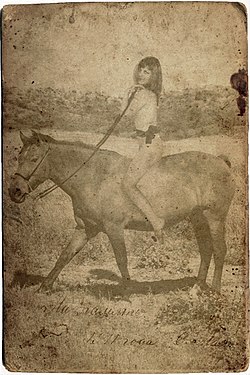
artwork from album "NUances of fantasy"
Retro style photography is an author's work that artificially imitates photographic images created many years ago.
About the genre and methods of implementation
[edit | edit source]The genre has no clear temporal boundaries of the displayed theme. Photography can be imitating any period, — from invention of photocamera to, for example, the 1980s; it is much more difficult to recreate a stylized picture of the ancient period or primitive communal system, but theoretically possible
You can achieve the retro effect by artificially wear out the image, but initially you need to photograph a scene "from the past", in which should be present, for example, household items of bygone times, people dressed old-fashioned with once popular hairstyles...
To transform the original photo works, use graphic editors that have ready-made filters, or (if they are not available) use special textures of an old faded paper, scratched metal etc.
Need to be aware
[edit | edit source]According to Wikipedia, retro is a style, but “retro photography” is already a genre.
Currently, there are no data on photographers who specialize exclusively in this genre
Gallery
[edit | edit source]A series of photographs taken by author of the textbook in China (April, 2013) during a long expedition that included 9 countries.
-
A man in hanfu
-
Zhouzhuang — Chinese Venice
-
Woman in hanfu
-
Zhouzhuang — Chinese Venice
-
Guard in ancient Chinese attire
External links
[edit | edit source]- "The Free Dictionary (retro- )". thefreedictionary. Retrieved April 23, 2023.
Creating ruins photographs

(Photo from book "Two hundred days in Latin America", p. 94)
Ruins photography is a genre (or sub-genre) of photographic art, the main theme of which is the depiction of abandoned, partially destroyed structures.
General information
[edit | edit source]This genre, which overlaps with architectural and landscape photography, is relatively recent. Popular among some photographers in the West, where sometimes referred to as "ruin porn" [1]. In Russia, the study of abandoned objects is engaged in stalkers, but they sometimes don't have a camera and set themselves other goals.
The main subject of photography is abandoned buildings of recent past: hospitals, bomb shelters, barracks, hotels, industrial plants, automobile cemeteries, prisons, etc. A side theme is the "mastering" of abandoned buildings by nature (see photo right). Historical monuments of architecture can sometimes serve as the subject of the genre, but only as an exception.
Ways of implementation
[edit | edit source]The process has similarities to Architectural photography, but if you are going to photograph underground objects or bunkers, you will need a flash, sometimes a powerful one, depending on the size of the object being photographed.
About where and how to find "photogenic" ruins, it is difficult to say: it depends on your location and willingness to overcome distances. Exept this you may have to buy additional equipment. As an option — to become a traveler, practicing hobo tourism, where sometimes you have to spend the night, or even live for a while in the ruins of abandoned houses.
Interesting fact
[edit | edit source]Abandoned buildings sometimes serve as a backdrop for creating works in nude photography, what can be classified as the intersection of the two genres.
Gallery
[edit | edit source]-
Darul Aman Palace (Afghanistan)
Photo taken on an Afghan expedition -
A dilapidated gatehouse on Eua Island (Tonga)
Photo taken on the Expedition to Oceania -
An abandoned building in Kuala Lumpur (Malaysia)
Photo taken on a Papuan expedition -
Abandoned structure near Tupisa (Bolivia)
Photo taken on a Latin American expedition -
"Apartment" on the island of Tongatapu (Tonga)
Photo taken on the Expedition to Oceania
References
[edit | edit source]- ↑ Heide Rampetzreiter. "Ruinen-Fotografie: Detroit liegt auch in Europa" (in German). diepresse.com. Retrieved April 23, 2023.
Self-portrait

"Afghan expedition"
Self-portrait is an image by the author of himself, in this case with the help of a camera. Can be considered as a separate genre, or (more precisely) a subgenre of portrait photography.
General information
[edit | edit source]The term self-portrait was originally conceived, refer to an artist's own portrait.
In relation to capturing oneself with a photographic apparatus, the word "selfie" has been relatively recently introduced, formed by the abbreviation of the term "self portrait" for a simplified pronunciation in colloquial speech.
However, if regarding to the work of artist, the concept of "self-portrait" indicates that the result belongs to art; “selfie” does not mean a work created as an art object (or with a claim to something creative), but is only an image of the owner of a camera or smartphone (tourist, vacationer, beachgoer, etc.) made by him with outstretched hand or using a special stick. Such photographs are created for commemorative (family) albums; publications in social networks; memories of tourist trips, vacations abroad and are not related to concept, the basics of which are covered in this textbook.
Ways of implementation
[edit | edit source]In order to make an exposure-quality, artistically portrait of yourself, preparatory steps will be required. Initially, you need to decide on the idea: what your portrait will mean, for what purpose it is conceived. Take a look at some examples:
- Self-portrait made for the textbook "Hobo Tourism Journalism", where the author is depicted with a notebook, pen and backpack, and it's symbolic;
- A variant created in the genre of photoart to illustrate a literary miniature is a staged work corresponding to the text content.
- The sample of stylized self-portrait for the book "Afghan Prisoner": it is forbidden to take a pictures in places of detention, a self-portrait was made upon returning from the expedition and placed on the inside cover page
Equipment
[edit | edit source]You can create a self-portrait using a tripod (if the camera is voluminous and heavy) or a clamp (if using a compact camera). It is easy to do without these accessories, following the example of the author, who is a supporter of hobo tourism (where lightweight equipment is used), for this you need to find a level support for the camera — a stump (in the forest), a parapet (in the city), a large stone or boulder (on sea or ocean coast), then set the built-in timer to the maximum time and move away, taking the required position. Modern digital technology, unlike analog (film) cameras, allows you to make an unlimited number of takes, removing unsuccessful options.
Gallery
[edit | edit source]-
With a refrigerator under palm trees (Tonga)
Photo taken on the Expedition to Oceania -
In the wilds of Africa (Zambia)
Photo taken on a Third creative trip to Africa -
Almost local (Kabul, Afghanistan)
Photo taken on an Afghan expedition -
5,000 won lunch (Suwon, South Korea)
Photo taken on the Expedition to Oceania
Creating works in staged photography

Staged photography is a genre of photographic art where the creator of a work, acting as a director, designs and creates a conceived scene, while paying attention to motive and design.
General information
[edit | edit source]The concept of "staging" came from the theater. Arranged photography, as it is sometimes called, having some resemblance to a theatrical performance, is designed to present the main idea of the work in a certain context and, as a result, evoke an emotional reaction in the viewer. Unlike scientific, documentary and reportage photography, realism is secondary here, the meaning of the depicted is important, where the author appears not as an objective observer, but as a creator trying to display the reality he conceived and created.
Ways of implementation
[edit | edit source]When planning to practice in this genre, it is useful, as an optional material, to get acquainted with the concept of Performance art, which, although not directly related to photography, will help you to feel the idea of creation.
Initially, you should think about the plot of the future photo work, decide what thoughts (feelings, memories) it will evoke in people. The audience's perception may vary: if there are several opinions about what you have displayed, it's a plus for the author: consequently the plot is not simple. Routine is the enemy of a creative personality.
The second part of the preparatory process will be the technical implementation of the plan. It is important to understand how complex the upcoming stage preparation that will be required to implement the idea. If it becomes technically impossible, you will have to change the subject, choosing (to begin with) something less complicated, not requiring hard labor, material costs and complex scenery. Taking the first steps to create trial works, you can choos the available emprovised means and the existing background, while using yourself or someone you know. Don't try to create a masterpiece with the first press of a camera button.
Experience comes with practice. For clarity, the text is complemented by a gallery of photographic works by the author of this textbook, the creation of most of which did not require special and lengthy training.
Should know
[edit | edit source]It is sometimes difficult (or even impossible) for the viewer to distinguish a staged photo from a real one: whether the situation is simulated, or whether the photographer caught an interesting moment by being in the “right” place in time.
Here is an example: this photo is not staged, the shoes that had served their due date, probably thrown away by one of the tourists because they were completely unusable, were lying on the grass and were photographed by the author.
But, theoretically, the owner of the camera could bring props with him, laying them out on the grass in accordance with the plan. Many such examples could be cited.
Gallery
[edit | edit source]-
White guest's gift (Zambia, 2011)
Self-portrait taken on a Third creative trip to Africa -
In the wilds of Africa (Zambia, 2011)
Self-portrait taken on a Third creative trip to Africa
-
With a refrigerator under palm trees (Tonga)
Photo taken on the Expedition to Oceania -
Past and present (Kabul, 2008)
Photo taken on an Afghan expedition -
Three elements (2010)
-
Seoul still life (South Korea, 2018)
Photo taken on the Expedition to Oceania -
Naked with phone (Vanuatu, 2011)
Photo taken on the Expedition to Oceania
-
Lumberjack (Papua New Guinea, 2013)
Photo taken on a Papuan expedition -
Fisherman (Sumatra, Indonesia, 2013)
Self-portrait taken on a Papuan expedition -
Caught! (Bolivia, 2015)
Photo taken on a Latin American expedition -
Fright (Brazil, 2015)
Self-portrait taken on a Latin American expedition
Creating works in straight (pure) photography

Photo taken in creative trip to India
Straight (pure) photography is a photography style, whose supporters adhere to the most accurate, realistic reflection of reality, where the object is always in focus, which allows you to see the details and there are all the qualities that distinguish photography from other forms of fine art.
General information
[edit | edit source]The movement originated in the West around the 1930s. Landscapes, people, architecture served as the subject of portray; and the distinguishing features are high image sharpness, sometimes maximum contrast and in addition — strict composition, the absence of blurry details, the inadmissibility of any additional transformations (both during shooting and during post-processing), natural richness of tones and lighting specifics.
Ways of implementation
[edit | edit source]The style is harmoniously combined with genre and street photography, experience in these genres will help you master the art of pure photography.
To create vivid images, you will need to work with lighting, expressive cropping (in order to remove “extra” space, level the horizon line, etc.) and other methods that do not require optical changes in the image.
The concept of direct photography taboos everything that can change the picture, making it less true. You should refuse to use light filters during shooting, and in post-processing — special development and printing processes; do not crop the image, as a result of which the perception of the meaning of what is happening can be changed (distorted).
In other words, the photographic work you create should recreate reality as the human eye sees it, without using staging, blurring or compositing.
Gallery
[edit | edit source]-
Checkered world (Afghanistan, 2008)
Photo taken on an Afghan expedition -
Cyclist (Sudan, 2011)
Photo taken on a Third creative trip to Africa -
Festive mood (Brunei, 2013)
Photo taken on a Papuan expedition -
Teacher and his blind mother (Indonesia, 2013)
Photo taken on a Papuan expedition -
Monks (Thailand, 2013)
Photo taken on a Papuan expedition
-
Young Traders (Papua New Guinea, 2013)
Photo taken on a Papuan expedition -
At the bus station (Paraguay, 2014)
Photo taken on a Latin American expedition -
Family business (Indonesia, 2013)
Photo taken on a Papuan expedition -
Waiting for the bus (Peru, 2015)
Photo taken on a Latin American expedition -
Индейцы (Mexico, 2015)
Photo taken on a Latin American expedition
Creating works in travel photography

One of the works from the personal photo exhibition "Hitchhiking across Sudan"
Travel photography is a genre that involves the depicting of nature, people with their traditions and customs, historical objects; in other words, everything that deserves to be captured during a visit to one or more countries.
General information
[edit | edit source]This genre is rooted in the research activities of scientific expeditions of the past centuries. Today everyone can creating photographs with views of distant countries: both the tourist from the category of vacationers (in order to fill the family album with memorable pictures), and the professional photographer (for subsequent publication of works in printed editions, or holding personal photo exhibitions). It should be noted that (regardless of skills and abilities) travelers, in particular supporters of Long intercontinental trips and expeditions, whose routes include visits to places where seldom have been foreigners, have a better chance of capturing something extraordinary.
Travel photography intersects with landscape and genre photography, as well as street photography and some other genres.
Ways of implementation
[edit | edit source]There is no universal scheme for achieving success. Buy a ticket to the islands of Oceania, or to Africa, planning to visit 5-10 exotic countries during the trip, and then luck will smile at you. Be prepared for overnight stays at construction sites, cemeteries, in public toilets, possible infection with tropical fevers and other unforeseen circumstances. Before leaving, it is advisable to familiarize yourself with the text of the textbook on hobo tourism.
See also
[edit | edit source]Night photography is an adjacent genre, the mastery of the art of which opens up new opportunities for a traveler.
Gallery
[edit | edit source]-
Sacred animal (India)
Photo taken in creative trip to India -
Pygmy people (Uganda)
Photo taken on a Second creative trip to Africa -
The food is still alive (Laos)
Photo taken on a Papuan expedition -
Excursion (Sudan)
Photo taken on a Third creative trip to Africa -
The owner of yurt (Mongolia)
Photo taken in Creative trip to Mongolia
Creating works in street photography

Photo taken on a Latin American expedition
Street photography is a genre of photographic art, where uses random events, incidents, scenes from life, etc. as its subject matter. Contrary to the first word contained in the name of genre, not only the street, but also any public places can serve as a space for action.
General information
[edit | edit source]This genre is a relatively new concept in photography. Its essence lies in the fact that the photographer, having found himself (more often involuntarily) in the right place at the right time, like a cowboy from American Western, deftly takes the camera out of "holster" to capture a scene which might not be there a second later. Usually there are people in the frame, but sometimes it happens that their presence is only implied (see photo 2 in the gallery).
Street photography is documentary in its essence and content, and designed to reflect the reality that surrounds us, but some authors artificially create scenes of events, inviting posing participants in order to later pass off the image as a random shot. Such actions are rather the exception to the rule.
Ways of implementation
[edit | edit source]Of course, it is not easy to go out every morning to "photohunt", hoping to see an interesting street scene: unsuccessful "outings" can last for weeks and months. Therefore, following the example of the author, become travelers: wandering around the cities and villages of the globe, sooner or later you will witness an interesting episode from the life of the natives of a particular country; all that remains is to quickly point the camera lens at what you sees and sharply press the shutter button. As an example, look the photoworks in gallery: they were shot by accident in different countries.
But if you are alarmed of the costs and difficulties that are inevitable in the life of a traveler — this is not your genre — test yourself, for example, in landscape photography.
Gallery
[edit | edit source]Photos taken by the author of article on a Papuan expedition
-
Gazing into the abyss (Laos)
-
Just yesterday they were barking (Kambodia)
-
Almost symmetry (China)
-
Queue (China)
Creating works in photoart

Photoart is a type of fine art that combines photography and computer graphics.
General information
[edit | edit source]Photomontage was used at the end of the last century and even earlier, but with the development of computer technology, creative people got unlimited opportunities for realize fantasies.
The photo collages created by the authors of past years have been left far behind, they have been replaced by works of art that are distinguished by a significant processing of the source material, visual effects and a higher artistic level. Sometimes the creations of masters of photoart imitate painting, but the result always based on photography, only in our time, digital has replaced analog image.
If the theme of works has fantasy, fabulous, mystical shades, — photoart intersects with other genres and directions.
Ways of implementation
[edit | edit source]The first and necessary condition is that you, a novice photographer, must have some degree of imagination. The source images can be created on purpose — for the realization of a particular idea or a series of works united by a conceptual idea, or, if you have a stock of ready-made photographs, you can use something from them as raw material.
A positive effect can be achieved by combining two or three source files into one, followed by processing by filters of graphics editors. It is difficult to predict the result, you need improvisation.
To begin with, you can practice creating relatively simple images, examples of which are illustrated in this tutorial article.
See also
[edit | edit source]Creating works in neosurrealism photography
Gallery
[edit | edit source]-
Illustration for the literary miniature
"Strange dream" -
Sunset
-
Illustration for the literary miniature
«Провинциальная история» -
Eclipse
-
Illustration for the literary miniature
"Persian tale"
Creating works in ethnographic photo genre

Ethnographic photographing is the process of depicting indigenous peoples, based on visual distinctive features expressed in elements of clothing, jewelry, and anatomical features of those being photographed.
General information
[edit | edit source]This direction of photography is documentary in nature. Ethnographic photography can serve both academic and social purposes: the genre is one of the auxiliary ways of gaining knowledge in ethnology; but in the life of a society not associated with science, also finds application. As an example, the images of aborigines in popular geographic magazines. Summarizing what has been said, we conclude: ethnographic photography is related to both scientific and travel photography.
Peculiarities of the genre and ways of realization
[edit | edit source]First of all, for the working in this genre, the visual qualities of the subject are important. An aboriginals who has moved to a big city, retaining his ethnicity but losing his visual appeal, is of no interest to the photographer. Conversely, for example, the Ethiopian Mursi people, whose women wear a ceramic saucer cut into their lower lip from childhood, are paramount.
Having experience in creating works of the ethnographic genre, I woud like note that natives living in hard-to-reach places of the globe, one way or another, occasionally see foreigners who managed to get to them, and they know that Caucasian race people come, for the most part, for the purpose of taking pictures "savages", therefore, be prepared for the fact that you will be asked for some payment for the opportunity to capture picturesque-looking inhabitants of godforsaken places on the planet. The amount, usualy, is not very large and discussed downward, however, after an agreement, aboriginal becomes in the “hands at the seams” position, which in his point of view should be done while posing in front of the cameral. You can use a telephoto lens, or zoom, catching a vital moment when the subject is in action. But for this you need to ideally quickly handle the camera, practicing dexterity in advance. If successful, your final work will intersect with genre photography, which will give it additional qualities, if not, you will get a standard ethnographic shot.
The theme of penetrating into places on the planet where the inhabitants of the virgin jungle have never seen a civilized person is not considered, because it requires large expenses and is not compatible with the basic principles of hobo tourism.
Gallery
[edit | edit source]-
Himba (Namibia)
Photo taken on a Third creative trip to Africa -
Ni-Vanuatu (Pentecost Island)
Photo taken on the Expedition to Oceania -
Samburu (Kenia)
Photo taken on a Second creative trip to Africa
-
Mongol on the cover of book
Mongolian huyvaldagch -
Himba on the cover of book
Third African trip -
Papuans on the cover of book
Six months by islands... and countries -
Pashtun on the cover of book
Afghan prisoner -
Ni-Vanuatu on the cover of book
Two months of wandering and 14 days behind bars
Wikisource
[edit | edit source]
Photo artist

Crimean Ethnographic Museum (February 6, 2023)
Photo artist is a term used in relation to a creative person who has the ability to aesthetically display the world around him with the help of a special optical instrument and graphic editors.
Figuratively speaking, "the poet of photography. Official sources sometimes use the synonym "master of artistic photography".[1]
General information
[edit | edit source]Perhaps, in some countries of the world, this concept can serve as an official career, but in Russia (where the author of textbook comes from), such a profession is not documented.[2]
From which it follows: photo artist is a hobby, or an additional quality of a photographer.
A bit of reasoning
[edit | edit source]Of course, a wedding photographer (the optimal application of the specialty, if the goal is to generate income), will become more popular, putting in their work a grain of creativity, but can you qualify the results of his labors, as a kind of art? In order to answer this question, we will resort to allegory, considering two options.
- Boil the chicken and eat it.
- Before the meal, place the bird on a dish, decorating with herbs, vegetables, etc.
Point 2 differs from point 1 in that it has a creative component; perhaps some eaters would describe the work of a cook using the epithet "art" or "chef's art", but inherent in real art, a figurative understanding of reality is not even implied here, therefore the two concepts should be distinguished, both in this case and in the above example of the wedding photographer. These professions are merely adjusting to the demand of the population, whereas true art should exist only for the sake of art (and not for the satisfaction of the masses or individuals).
Think for yourself, decide for yourself...
[edit | edit source]What is the purpose of the above information? If the author, choosing the commercial path, shooting anniversaries, holidays and children's parties, will add a grain of artistry to his work, customers will appreciate it, which will be reflected in additional orders and, consequently, increase his (her) popularity and income. But one who gives preference to creative goals, for example engaging in experimental photography, will receive (at best) only positive feedback, which is unlikely to be accompanied by a material component; devoting himself to abstract photography, perhaps, he (she) will not be understood by society. In other words, creative research is at one's own expense.
Photographer / photo artist, similarities and differences
[edit | edit source]The photographer, usual, passively performs the tasks set by the client or the management; the photo artist can improvise, both with the post-processing of the resulting image and with the actions that precede the shooting. For the first, it is enough that the customer is satisfied with the result, the second can (and should) be in constant search.
How to become a photo artist?
[edit | edit source]- The first and necessary condition is the presence of artistic taste (or aesthetic consciousness).
- To begin with, it is enough to have the simplest camera: expensive models will distract from the goal.
- Choose one (or two) genres that appeal to you by carefully studying the textbook materials, in particular, all the enclosed photo examples.
- Determine for yourself the scope of work according to the chosen genre, having developed a concept.
But first of all you should decide whether you need it...
***
Below are examples: the first gallery contains works created by a photographer, the second — a photo artist. But everything presented to your attention is done ... by one author.
Gallery I
[edit | edit source]-
At the end of the road
(Realism) -
In the Chinese subway
(Pictures of homeless people) -
Indians
(Reportage photography) -
Teacher and his blind motherь
(Straight/pure photography) -
Remains of the apartments
(Ruins photographs)
Gallery II
[edit | edit source]-
Lunar landscape
(Experimental photography) -
Mirage?
(Conceptual photography) -
In the emerald darknes
(Photoart) -
Family
(Pictorialism)
References
[edit | edit source]- ↑ "An example of the use of the term "master of artistic photography"". search.rsl.ru/ru (in Russian). Retrieved April 23, 2023.
- ↑ "Справочник кодов общероссийских классификаторов". classinform.ru (in Russian). Retrieved April 23, 2023.
- This article is a translation adapted to the realities of the English-speaking world. Perhaps some of the theses correspond only to Russian reality.
Egypt and Egyptians

Egypt and the Egyptians — the debut personal photo exhibition of Viktor Pinchuk, held at the House of Artists (Simferopol) from 3 to 17 June 2005.
General information
[edit | edit source]For the admirers of exotica and photo art were presented with 21 works, most of which belong to the lifestyle photography, which is typical for for early stage of the creative activity of the Crimean traveler.
The abode of eternal summer, where there is never snow, and rain is an extremely rare phenomenon, is displayed briefly and clearly: the images of the poor people interspersed with bright, sparkling night lights restaurants and hotels, presenting an objective picture of the North African country; and, of course, did not do without the symbol of Egypt — ancient pyramids.
The photographic material was captured during a tourist trip that included visits to Hurghada and Cairo.
Links
[edit | edit source]- М. Киселёва. "«О стране вечного лета и древней мудрости» — Republic of Crimea: newspaper. — 10.06.2005. — № 21". wikimedia.org (in Russian). Retrieved April 23, 2023.
Egypt and Egyptians II

Egypt and the Egyptians (II) is the second solo exhibition of the traveler and photographer Viktor Pinchuk, which opened on February 13, 2006 in the Simferopol Art Museum and lasted one month.
General information
[edit | edit source]A selection of 48 works, presented at the vernissage, was made up of two parts: 21 copies — from the debut exhibition of author, held in the Crimean House of Artists and 27 new, previously not exhibited. Most of the presented works were combine elements of two creative directions — genre and reportage photography.
The collection included photographic material shot on a tourist trip where the main route was through Cairo and Hurghada.
Links
[edit | edit source]- "The act of accepting photo works by the museum (document)". upload.wikimedia.org (in Russian). Retrieved April 23, 2023.
Lights of Moscow

Lights of Moscow — the third personal exhibition of Viktor Pinchuk, held at the summer of 2006 in the exhibition hall of the Russian Cultural Center (Simferopol).[1]
Background
[edit | edit source]Transit through Moscow was a necessary segment of the itinerary of the First creative trip to Africa, particularly in terms of obtaining an Ethiopian visa.
The night views of capital city were shot using a tripod and analog camera. It was not without a minor misunderstanding. By placing his massive equipment on Red Square, the author of the future exhibition aroused the suspicions of the Moscow police, who were patrolling the city: they mistook a Crimean photografer for an illegal entrepreneur, intending to earn money on late-night walkers, but soon law enforcement officers realized what had happened, wish good luck and gone. [2]
References
[edit | edit source]- ↑ А. Армашевская. "Русский культурный центр (новости) — упоминание о прошедшей выставке". web.archive.org (in Russian). Retrieved April 23, 2023.
- ↑ В. Пинчук. "Девять шагов с «мыльницей» наперевес (совет третий)". ru.wikisource.org (in Russian). Retrieved April 23, 2023.
Ethiopia through the eyes of traveler

Ethiopia through the eyes of a traveler — fourth personal exhibition of the photographer and traveler Viktor Pinchuk, which was held from 4 to 18 October 2006 in the Crimean Artist's House (Simferopol), where the regional branch of the National Union of Artists of Ukraine was located, in the referral of which author visited the African country.
General information
[edit | edit source]At the vernissage 30 works were presented, most of them belonging to genre photography: everyday subjects, street scenes, images of ordinary people. Visitors saw caught moments from the lives of natives — Mursi women who pierce their lower lips at an early age in order to carry a ceramic saucer in it for the rest of their lives; market traders; homeless people and beggars. The material was printed from the film negatives of the analog camera used.
Backstory
[edit | edit source]First creative trip to Dark Continent became embodiment of idea about photo session in Equatorial Africa: Egypt, which served as the subject for the author's first and second personal exhibitions, is inhabited by Arabs, therefore visually looks more like Asia.[1]
Traveling along the route with transfers took several days. [1] The movement of passenger transport here has a peculiarity: during the rainy season, mountain roads covered with terracotta clay are blurred by mudflows — for the driver and passengers are in danger of falling into the precipice, so traffic is temporarily suspended. The above problem, combined with a short period of time remaining before the return flight, was the reason that the plan was only partially fulfilled. [1]
Gallery
[edit | edit source]-
Darwin was right
-
Angry woman
-
The meal
-
Outskirts of Addis Ababa
-
Homeless
References
[edit | edit source]Links
[edit | edit source]- В. Пинчук. "Эфиопия глазами путешественника — Crimea.ru: newspaper. — 15. 08. 2007. — № 56 (163)". wikimedia.org (in Russian). Retrieved April 23, 2023.
- В. Пинчук. "Симферополь — Аддис-Абеба — Evening City: newspaper. — 06. 07. 2007. — № 47 (66)". wikimedia.org (in Russian). Retrieved April 23, 2023.
- Referral on a creative trip (document)
On the roads of India


On the roads of India — fifth personal exhibition of the photographer and traveler Viktor Pinchuk, which was held from April 2 to April 15, 2007 in the Crimean Artist's House (Simferopol), where was located the regional branch of the National Union of Artists of Ukraine, by the referral of which author visited India.
General information
[edit | edit source]Creative trip to India lasted two weeks; the route included eight cities: Delhi, Agra, Jaipur, Ajmer, Vadodara, Surat, Margao, Mumbai, Bandra.[1].
Works of genre and street photography dominated the presented collection Realistic situations of Indian life were complemented by images of ancient architecture, animals and deities. The neighborhood of majestic palaces and mausoleums with complete unsanitary conditions surprised some viewers who were brought up on the beauty of Indian movies.
Conception of the cultural and geographical project included not only holding an exhibition: author wrote several articles describing exotic country, its inhabitants and traditions, in particular "God is one... In 200 Persons" (see below), about the peculiarities of Indian religion (as understood by a European); few years later a brochure "Indian Dreams" was published.
Wikisource
[edit | edit source]- God is One… in 200 Persons — page from the story of exhibitionʹs creation.
References
[edit | edit source]- ↑ Pinchuk, Viktor. Indian dreams (in Russian). Russia: Brovko. p. 40. ISBN 978-5-9909912-6-2.
Links
[edit | edit source]- "Announcement of the exhibition (postscript to the article) — Crimean time: newspaper. — 29.03.2007. — № 35 (2421)". wikimedia.org (in Russian). Retrieved April 23, 2023.
14 days in Mongolia

14 days in Mongolia — the sixth personal exhibition of the Russian traveler and photographer Viktor Pinchuk that was held in the exposition hall of the Russian Cultural Center in Simferopol from October 10 to 31, 2007.[1] More than half of the presented works are landscapes, the rest belong to genre photography.
Backstory
[edit | edit source]Material prepared during a creative trip to the country of the steppes, which took place in May of the same year. The route, not popular among foreign tourists, was chosen by the author of photo exhibition for several reasons; one of them is to master a new genre: the deserted spaces of an Asian country, overgrown with taiga vegetation — an eldorado for shooting landscapes.
Khatgal is located on the coast of Lake Khövsgöl. At that time, there was no electricity in the village, and a few guests — admirers of ecological tourism, were settled in yurts heated with a stove. [2]
In addition, the route list included: Kharkhorin, where the capital of Mongol Empire, founded by Genghis Khan, was located; Arvaikheer, Bayankhongor and Zuunmod, near which is the Manjusri Monastery.[2]
Gallery
[edit | edit source]-
Erdene Zuu Monastery (Kharkhorin)
-
Lake Khövsgöl
-
Master of the yurt (Kharkhorin)
-
A narrow strip (Mörön)
References
[edit | edit source]- ↑ "City poster — Evening city: newspaper. — 26.10.2007. — № 78 (97)". wikimedia.org (in Russian). Retrieved 2020-12-26.
- ↑ a b Pinchuk, Viktor. Mongolian huyvaldagch (in Russian). Russia: Brovko. p. 40. ISBN 978-5-9909912-1-7.
Links
[edit | edit source]- A. Armashevskaya. "Монгольские истории — Russian Cultural Center (news)". web.archive.org (in Russian). Retrieved April 23, 2023.
- О. Minskaya. "14 дней в Стране великих степей — Evening city: newspaper. — 8.10.2007. — № 73(92)". wikimedia.org (in Russian). Retrieved April 23, 2023.
- L. Milina. "14 дней в Монголии — Crimean truth: newspaper. — 25.10.2007. — № 195 (24298)". wikimedia.org (in Russian). Retrieved April 23, 2023.
- О. Smirnova. "Шесть фотовыставок в дар городу — Evening city: newspaper. — 26.10.2007. — № 78 (97)". wikimedia.org (in Russian). Retrieved April 23, 2023.
Uganda: tribes and civilization

Uganda: tribes and civilization — the seventh personal exhibition of Viktor Pinchuk, held at the Artist's House (Simferopol) from 2 to 15 June 2008.
The conception
[edit | edit source]The author's original intention — to depict the similarities and differences between inhabitants of the cities and provincial parts of African country — is embodied in the photographic collection. Most of the works displayed moments of everyday life in the Ugandan hinterland, while a few scenes of urban life are added for comparison. “Children of primeval nature or city dwellers, who impresses you?” — a question that each visitor of the exhibition had to solve independently.
Aborigines gazed from the walls of exhibition hall, captured at the moment of doing their daily routine against the backdrop of picturesque African huts and landscapes.
This period of the Crimean photographer's creativity is characterized by a mixture of ethnographic and genre photography.
Backstory
[edit | edit source]The second creative trip to Africa (part of a multifaceted author's project, in terms of holding an exhibition agreed with the Crimean Organization of the Union of Artists) lasted a month.
Author managed to get to Kampala by a shuttle bus from Nairobi, thanks to an acquaintance with a Ugandan man who arrived in the Kenyan capital to apply for a visa; from him received information, which was used as a basis for compiling the itinerary.[1]
Karamoja is an inaccessible region of Uganda, rarely visited by foreigners because of its lack of roads.[2] The Karamojong people who inhabit these places build their dwellings out of branches and use thorny bushes as doors, dragging them inside for the night.[2]
The itinerary also included a visit to the Pygmies, a small community of which is located in the rainforest near Bundibugyo.[1]
Gallery
[edit | edit source]-
At work (Kiru village, Abim District, Karamoja)
-
Pygmy women
Materials in Wikisource project
[edit | edit source]
References
[edit | edit source]Links
[edit | edit source]- Announcement of the photo exhibition — Crimean Time: newspaper. — 2.11.2006. — № 57 (2589)
- L. Obukhovskaya «Лицом к лицу с пигмеями» (report from the photo exhibition) — Crimean Truth: newspaper. — 21.06.2008. — № 112 (24455)
- M. Samokhin «Пинчуку повезло, что его не съели» — Express-gazette: newspaper. — febr.2008. — № 6 (679)
Tribes of Kenya

Tribes of Kenya — the eighth personal exhibition of traveler and photographer Viktor Pinchuk, which was held at the Central Museum of Taurida, from March 23 to April 23, 2012.
General Information
[edit | edit source]Collection of photo works belonging to the ethnographic genre acquainted the guests of the vernissage with the peoples living in hard-to-reach areas of the equatorial country. In addition to television and press, the museum management invited students of Medical Academy — Kenyans who, being mainly residents of the capital, were surprised to see the photos depicting their compatriots from the hinterland.
Background
[edit | edit source]The photographic material were captured during the second creative trip to Africa, the route of which included two states. The coast of Lake Rudolph, in particular, Loiyangalani village (or small town), is inhabited by indigenous peoples who have retained their identity — El Molo, Samburu, Rendille and Turkana, the first letters of whose names form the word MOSARETU, which characterizes the community.
Author of exhibition had make way to the route aim for several days, with transfers. Only large trucks with goods, on top of which people are located, can be used as the only possible “passenger” transport, connecting the civilized part of the country with the outskirts, where there is no electricity, basic amenities (so habitual for a European) and in a few tiny shops, possibile buy only bottled drinks and cereals, which delivered to these parts on lorries, that plying infrequently and without a schedule.[1]
Quote
[edit | edit source]Each of my photo works is a small window in the wall of the exhibition hall through which you can see a piece of Africa.[2]
Gallery
[edit | edit source]-
Loiyangalani
-
Rendille
-
El Molo
-
Samburu
-
Turkana
External links
[edit | edit source]- "В Симферополе открылась фотовыставка крымского фотографа и путешественника «Племена Кении» (фото)". novoross.info (in Russian). Retrieved April 22, 2023.
- "Television report (ИТВ TV Company)". youtube.com (in Russian). Retrieved April 23, 2023.
- "Television report (ЧТРК TV Company)". youtube.com (in Russian). Retrieved April 23, 2023.
- Kenyan students enthusiastically look at exhibition works (photo)
References
[edit | edit source]- ↑ Viktor Pinchuk. "In search of the Lost Tribes". en.wikisource.org. Retrieved April 23, 2023.
- ↑ "Виктор Пинчук покажет симферопольцам кусочек Африки". www.3652.ru (in Russian). Retrieved April 23, 2023.
Egypt and Egyptians III

Egypt and Egyptians III — the ninth personal exhibition of the traveler and photographer Viktor Pinchuk, held in the exposition hall of Russian Cultural Center in Simferopol from September 27 to October 27, 2012.
General information
[edit | edit source]A series of photographs created as a result of the first and third creative trips to Africa served as an occasion for holding another personal photo exhibition about Egypt, the opening of which, by decision of RCC management, was timed to coincide with the "Tourism Day".
Collecting material, author visited pyramids area in El Faiyum, relatively little known among tourists: of Amenemhet III (in Hawara) and Senusret II (in El Lahun). In addition, on the way to Sudan (to which a separate exhibition was dedicated), author visited Luxor and Aswan, where the surviving architectural objects created by representatives of ancient civilization were filmed: Karnak and Luxor temple.[1] Along the way, a number of genre shots were taken.
Despite the fact that more than 80% of photographs from previous photo exhibitions held under the same name at the Central Artist's House (2005) and the Simferopol Art Museum (2006) were replaced by new ones, the press and television have ignored the event, apparently deciding that the new exposition is identical to the two previous ones.
Wikisource
[edit | edit source]- Viktor Pinchuk «Один день в египетской деревне» (in ru) — one day from the history of creation an exhibition.
References
[edit | edit source]- ↑ Pinchuk, Viktor. Third African trip (in Russian). Crimea, Simferopol: Fenix. p. 56. ISBN 978-617-671-039-4.
January in Japan

January in Japan — the tenth personal exhibition of traveler and photographer Viktor Pinchuk, were held at the Central Museum of Taurida (Simferopol).[1] The opening took place on October 7, 2013. The exposition, which included 45 works, introduced connoisseurs of photographic art and representatives of the press who were present at the ceremony to the sights of islands Shikoku, Honshu and Enoshima, which the author managed to visit during the short period of validity of visa.[1]
Backstory
[edit | edit source]The two-week trip took place in the "hobo tour" format. In order to collect photographic material, crimean thrill-seeker traveled through winter Japan using the kiseru method; he slept on technical floors of buildings, under the elevator of the student dormitory, in a cemetery, even in a police station, and once, by coincidence, stayed overnight at home of local TV cameraman.[2] The result was worth the effort: in addition to imported photographic collection, the author published a series of articles about the country, which never ceases to amaze us today, as it did in past centuries. Later a brochure "Japan for free" created in the genre of travel notes was came out.[3]
Gallery
[edit | edit source]-
Evening street (Okayama)
-
In the local train
-
Overnight in the cemetery (Kamakura)
-
Todaiji temple (Nara)
References
[edit | edit source]- ↑ a b "Крымчанам покажут "Январь в Японии"". taurica.net (in Russian). Retrieved April 23, 2023.
- ↑ Pinchuk, Viktor. Japan for free (in Russian). Russia: Brovko. p. 32. ISBN 978-5-9908234-1-9.
- ↑ Republic of Crimea (newspaper). — 2012/ № 8 (941); 9 (942); 10 (943); 11 (944); 12 (945); 13 (946); 15 (948); 16 (959); 17 (950).
Links
[edit | edit source]- "Photo exhibition "January in Japan", TV report / ИТВ company (in ru)". youtube.com (in Russian). Retrieved April 23, 2023.
- "В Столице Крыма открыли выставку фотографа-путешественника о Японии (An exhibition by a photographer-traveler about Japan was opened in the Crimean capital)". taurica.net (in Russian). Retrieved April 23, 2023.
- "В Симферополе представили выставку «Январь в Японии» (The exhibition "January in Japan" was presented in Simferopol)". kianews.com.ua (in Russian). Retrieved April 23, 2023.
- "«Зима в Японии»: выставка фоторабот Виктора Пинчука ("Winter in Japan": an exhibition of photographic works by Viktor Pinchuk)". taurica.net (in Russian). Retrieved April 23, 2023.
Hitchhiking across Sudan

Hitchhiking across Sudan — the 11th personal exhibition of traveler and photographer Viktor Pinchuk, held at the Museum of Simferopol History, located on the main street of the Crimean capital, from 8 to 29 July 2014.
Backstory
[edit | edit source]The three-month itinerary, which included six African countries, was full of events, adventures, overnight stays in abandoned buildings, in a flophouses, at the police stations, and other unusual places. The trip coincided with a period of turmoil with clashes between rebels and Sudanese government troops. During less than a month of his stay in the Muslim country, the author of the future exhibition had time to visit several localities, but not everything he planned could be realized. On December 25, 2010, while making his way to the Nuba Mountains, two weeks before the six-day referendum that marked the beginning of Sudan's division into two countries, he was detained by the intelligence services of Sudan in Kadugli and sent to Khartoum.[1]
References
[edit | edit source]- ↑ Pinchuk, Viktor. Third African trip (in Russian). Russia: Simferopol: Phoenix Enterprise. p. 19. ISBN 978-617-671-039-4.
Links
[edit | edit source]- "«Автостопом по Судану»: в Симферополе открылась экзотичная фотовыставка ("Hitchhiking across Sudan": an exotic photo exhibition opened in Simferopol)". crimea-news.com (in Russian). Retrieved April 23, 2023.
- Y. Poteryaiko. "Судан на Пушкинской". c-pravda.ru (in Russian). Retrieved April 23, 2023.
Afghanistan, 2008

Afghanistan, 2008 — the twelfth personal exhibition of Russian photographer Viktor Pinchuk, held at the Crimean Ethnographic Museum from 6 to 28 February 2023.
Backstory
[edit | edit source]A two-month expedition, the route of which included seven Asian countries, was planned by the author of photo exhibition in order to collect material.
Getting into Afghanistan was carried out from Termez to Hairatan along the Friendship Bridge.
Upon arrival, it turned out that not all provinces of Afghanistan are accessible to a foreigner. The reason is the limited ability of government forces to ensure law and order in the country and, as a result, the presence of territories controlled by gangs. As a result, managed to visit only the northern regions, while not avoiding minor problems: before boarding a minibus heading towards Bamyan (replete with picturesque views for landscape photography), had to change into a Pashtun costume, as the drivers flatly refused to provide transport services to a to a visiting European for fear of meeting with terrorists who involved in hostage-taking for ransom.
Quote
[edit | edit source]The solo expedition, whose main púrpose was to visit Afghanistan, ended successfully: stay in country, rated as the most dangerous and undesirable for tourism, went off without a major incidents; a short "rest" in Kabul prison served as the event around which unwinds plot of the book "Afghan prisoner", becoming one of adventures, without which our life would have turned into a dull execution of duties. But, main important, material for the photo exhibition was prepared in accórdance with the idea, safely delivered to the homeland, and presented in the museum exhibition hall.[1]
Short description
[edit | edit source]Exhibition works can be divided into the following groups: landscape, portrait, genre, street, narrative photography. Most of the works are stylistically united by the theme of straight (pure) photography, and images of people in traditional clothes belong to the ethnographic genre.
Gallery
[edit | edit source]-
Rock "Stone crematorium" (Bamyan Province)
-
Engaged in conversation (Mazar-i-Sharif)
-
Sight (Mazar-i-Sharif)
-
In the valley (Bamyan Province)
-
Chardi village, Only street
Materials in sister projects
[edit | edit source]Wikisourse
[edit | edit source]- Viktor Pinchuk "One day in Afghan prison"

Wikinews
[edit | edit source]Viktor Pinchuk presents exhibition Afghanistan, 2008 in Simferopol, Crimea
External links
[edit | edit source]- "Презентация персональной фотовыставки Виктора Пинчука «Афганистан, год 2008»". ethnocrimea.ru (in Russian). Retrieved April 23, 2023.
- "«Афганистан, год 2008-й», торжественное открытие фотовыставки". afisha7.ru (in Russian). Retrieved April 23, 2023.
- Л. Милина. "«Афганистан, год 2008-й»". c-pravda.ru (in Russian). Retrieved April 23, 2023.
- "Воины-интернационалисты посетили фотовыставку Виктора Пинчука «Афганистан, год 2008»". rsva-crimea.ru (in Russian). Retrieved April 23, 2023.
- "В Крымском этнографическом музее открылась фотовыставка «Афганистан, год 2008»". crimeapress.info (in Russian). Retrieved April 23, 2023.
- "В Крымском этнографическом музее представлена персональная фотовыставка Виктора Пинчука «Афганистан, год 2008»". mkult.rk.gov.ru (in Russian). Retrieved April 23, 2023.
- С. Ефремова. "Афганские фотозарисовки". new.crimiz.ru (in Russian). Retrieved April 22, 2023.
- "В Крымском этнографическом музее представлена персональная фотовыставка В. Пинчука «Афганистан, год 2008»". crimea-news.co (in Russian). Retrieved April 23, 2023.
References
[edit | edit source]- ↑ "About the creation of exhibition (video)". commons.wikimedia.org. Retrieved April 23, 2023.












